矿物加工专业英语复习资料
矿物加工专业英语复习资料

Unit1 Lesson11 矿物(minerals)Minerals definition:Minerals by definition are natural inorganic substances possessing definite chemical compositions and atomic structures.矿物的定义:具有稳定的化学成分、晶体结构的天然无机化合物。
Mineral types:native and metallic form,oxides,sulphides, carbonates,silicates and chlorides.矿物的种类:主要按化学成分划分:单质矿物、氧化物、硫化物、碳酸盐、硅酸盐、卤化物等。
Isomorphism:substitution of atoms within the crystal structure by similar atoms takes place without affecting the atomic structure.类质同象:矿物晶体中的原子被类似原子取代而不改变矿物晶体结构的现象。
例如:铁橄榄石—镁橄榄石。
Polymorphism: different minerals have the same chemical composition,but markedly different physical properties due to a difference in atomic structure。
同质多象:矿物的化学成分相同,但晶体结构和物理化学性质不同的现象。
例如:金刚石、石墨。
Rocks: Rocks consist of a variety of minerals and form large parts of the earth's crust. Granite,for instance,which is the most abundant igneous rock,is composed of three main mineral constituents, feldspar,quartz, and mica。
矿物加工专业英语
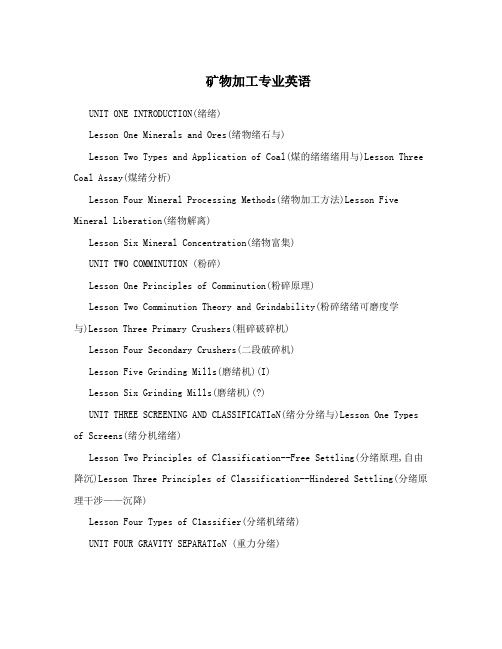
矿物加工专业英语UNIT ONE INTRODUCTION(绪绪)Lesson One Minerals and Ores(绪物绪石与)Lesson Two Types and Application of Coal(煤的绪绪绪用与)Lesson Three Coal Assay(煤绪分析)Lesson Four Mineral Processing Methods(绪物加工方法)Lesson Five Mineral Liberation(绪物解离)Lesson Six Mineral Concentration(绪物富集)UNIT TWO COMMINUTION (粉碎)Lesson One Principles of Comminution(粉碎原理)Lesson Two Comminution Theory and Grindability(粉碎绪绪可磨度学与)Lesson Three Primary Crushers(粗碎破碎机)Lesson Four Secondary Crushers(二段破碎机)Lesson Five Grinding Mills(磨绪机)(I)Lesson Six Grinding Mills(磨绪机)(?)UNIT THREE SCREENING AND CLASSIFICATIoN(绪分分绪与)Lesson One Types of Screens(绪分机绪绪)Lesson Two Principles of Classification--Free Settling(分绪原理,自由降沉)Lesson Three Principles of Classification--Hindered Settling(分绪原理干涉——沉降)Lesson Four Types of C1assifier(分绪机绪绪)UNIT FOUR GRAVITY SEPARATIoN (重力分绪)Lesson One Principles of Gravity Concentration(重绪原理)Lesson Two Jigs(跳汰机)Lesson Three Shaking Tables(绪床)Lesson Four Other Gravity Separators(其他重绪绪绪)UNIT FIVE HEAVY MEDIUM SEPARATIoN(重介绪分绪)Lesson One Principles of Heavy Medium Separation(重介绪分绪原理)Lesson Two Separation Vessels of Heavy Medium Separation(重介绪分绪绪绪)Lesson Three Laboratory Heavy Liquid Tests(绪绪室重液绪绪)UNIT SIX MAGNETIC AND ELECTRICAL SEPARATION(磁绪分绪)Lesson One Magnetic Separation(磁力分绪) Lesson Two Magnetic Separators(磁力分绪绪绪)Lesson Three Electrostatic Separation(静绪分绪)UNIT SEVEN FLOTATION(浮绪)Lesson One Principles of Flotation(浮绪原理)Lesson Two Thermodvnamics and Kinetics of Flotation(浮绪绪力绪力学与学)Lesson Three Collectors I(捕收绪I)Lesson Four Collectors II(捕收绪II)Lesson Five Frothers(起泡绪)Lesson Six Regulators (绪整绪)Lesson Seven Flotation Circuits and Machines(浮绪回路及浮绪绪绪)UNIT EIGHT GOLD EXTRACTIoN(黄金提取)Lesson One Gold—Properties and Applications(黄金的性绪和绪用)Lesson Two Gold Cyanide Leaching(黄金的绪化浸出)Lesson Three Carbon-in-Pulp Process and Carbon—in-Leach Process(炭绪法与炭浸法)Lesson Four Gold Smelting(黄金冶绪)Lesson Five Gold Refining(黄金精绪)UNIT NINE DEwATERING AND TAILINGS DISPOSAL(脱与水尾绪绪理)Lesson One Coagulation and Flocculation(凝聚絮凝与)Lesson Two Sedimentation(沉淀)Lesson Three Filtration and Drying(绪绪和干燥)Lesson Four Tailings Disposal(尾绪绪理)。
矿物加工专业英语 词汇(字典版)
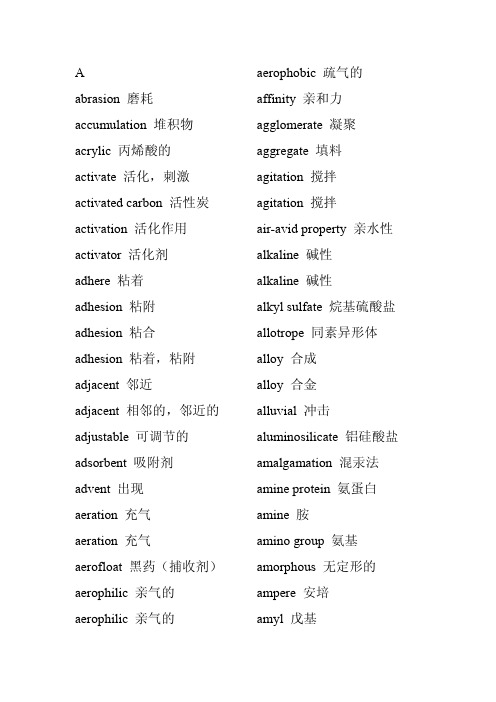
Aabrasion 磨耗accumulation 堆积物acrylic 丙烯酸的activate 活化,刺激activated carbon 活性炭activation 活化作用activator 活化剂adhere 粘着adhesion 粘附adhesion 粘合adhesion 粘着,粘附adjacent 邻近adjacent 相邻的,邻近的adjustable 可调节的adsorbent 吸附剂advent 出现aeration 充气aeration 充气aerofloat 黑药(捕收剂)aerophilic 亲气的aerophilic 亲气的aerophobic 疏气的affinity 亲和力agglomerate 凝聚aggregate 填料agitation 搅拌agitation 搅拌air-avid property 亲水性alkaline 碱性alkaline 碱性alkyl sulfate 烷基硫酸盐allotrope 同素异形体alloy 合成alloy 合金alluvial 冲击aluminosilicate 铝硅酸盐amalgamation 混汞法amine protein 氨蛋白amine 胺amino group 氨基amorphous 无定形的ampere 安培amyl 戊基analogous 类似的ancillary 辅助anion 负离子anionic 阴离子的anionic 阴离子的,带负电的annular 环形的apex 沉砂口apparent viscosity 表观粘度apparent 外观上的applicable 适用的appraisal 评价appraisal 评价,估计approximately 接近地aqua regia 王水aqueous chemical extraction process 湿法化学提取arcing 电弧作用aromatic alcohol 芳香醇arsenic 砷的,含砷的arsenopyrite 毒砂arsenopyrite 砷黄铁矿,毒砂artificial satellites 人造卫星asbestos石棉ascend 提升assay 试验assess 评定astronauts 宇航员asymmetric 不对称的,不均匀的at will 任意的atomize 雾化,粉化attrition 磨损augment 增加auric 金的,含金的,三价金的auride 金化物aurocyanide complex 氰化金络合物aurocyanide 氰亚金酸盐aurous 亚金的,一价金的aurum 金availability 来源axis 轴线azurite 蓝铜矿Bback-fill 回填(料)back-filling 回填baffle 导流板,栅板balium 钡barite 重晶石barren 贫瘠的batch flotation cell 单槽浮选机bath (重介质)分选槽beach sand 海滨砂beamed 定向的bismuth 铋blade 叶片,刀刃blend 混合blower 鼓风机boil 沸腾bonding sites 活性点borax 硼砂boron 硼borrowed fill 外来料bowl 滚筒brass tube 黄铜管bridge thickener 桥梁式浓密机bromide 溴化物bromoform 溴仿,三溴甲烷bronze 青铜bubble 气泡bulk-oil floatation 全油浮选bullion 金块by convention 按照惯例by virtue of 根据Ccaesium 铯cake filter 饼式过滤机calacerite 碲金矿calcined 煅烧calcite 方解石calcium fluoride 氟化钙calcium hydroxide 氢氧化钙calibrated orifice plate 调节孔板caloium 钙capital 资本carbon disulphide 二硫化碳carbon tetrachloride 四氯化碳carbonaceous 碳质的carbon-in-leach 炭浸法carbon-in-pulp process 炭浆法carbonyl 羰基carboxyl 羧基carboxylate 羧酸盐carnallite 光卤石cascade cell 喷流槽,泻落槽cassiterite 锡石catalyst 催化剂cater 满足cationic 阳离子的caustic 腐蚀性的cement 水泥centrifugal 离心的centrifugal 离心的centrifuge 离心机ceramics 陶瓷业cerussite 白铅矿chalcopyrite 黄铜矿chamber or recessed plate filter press 箱式或凹板式压缩机charcoal 木炭chemisortion 化学吸附作用chlorauric 氯金酸chlorination 氯化,用氯气处理chute 斜槽chute 装矿溜口circuit 回路circulating loads 循环负荷clarification filter 澄清式过滤机clarifier 澄清机clarifying capacity 澄清能力clarity 透明clean 精选cleaner cell 精选槽cleaner 品位高clerici solution 克列里奇夜coagulant 凝聚剂,凝结剂coagulation 凝结,凝聚coagulation 凝聚coagulator 凝聚剂coal preparation engineer 选煤工程师coalescing 兼并cobbing 粗选coconut shells 椰子壳collection 回收collection 收集collectors 捕收剂collidal 胶体collide 碰撞collide 碰撞collieries 煤矿colloidal 胶体colloidal 胶体的come into contact with 与- -接触commercial scale工业规模compatible 兼容,共处compensate 补偿complete 完全的complexant 配位剂component 组件compound 化合物compressed 扁平的comprise 包括concentration 浓度concurrent low-intensity magnetic separator 顺流式弱磁选机conditioning 调浆conducting particles 导电颗粒conductor grain 导体颗粒confined 限制connote 意味着constituents 成分constituents 组分,成分contact angle 接触角contamanant 污染物质,杂质contaminate 污染,混杂contaminated 受污染的contamination 污染controversial 有争议的conventional 常规的,常见的conventional 常见的conventional 常见的converge 集中converging field 收敛磁场converse 聚合conversely 相反的copper matte 冰铜copper sulphate 硫酸铜copper sulphide 硫化铜corona discharge 电晕放电corresponding 一致的,相应的corrosion resistant 耐腐蚀corrosion 腐蚀corrosion 腐蚀,侵蚀corrosive 腐蚀性的counter current decantation 逆流洗涤counter-current 半逆流counter-ion 反离子counter-rotation 逆流式covalent 共价的cresol 甲酚crest 顶端cresylic acid 甲酚酸crucible 坩埚crystal lattice 晶格crystallization 结晶cumulative 累积的cupellation 灰吹法cyanide 氰化物cyanide 氰化物cylinder 圆柱体cylindrical 圆柱的cylindroconical 圆柱圆锥型Ddecant 澄清的definite 明确的degradation 降解,退化,分解depleted 贫化,耗尽depress 抑制depression 抑制剂descending 下降的detachment 分离,脱离dewater 浓缩,脱水dextrin 糊精diagrammatically 用图表地,概略地diamagnetic 逆磁性diffused 扩散dilute 减少,稀释dilute 稀释diluted 稀释dipole 偶极direct flotation 正浮选discarded 丢弃discrete particles 分散颗粒dispersant 分散剂dispersed 分散dispersing 分散disposal 处理disseminate 传播disseminated 散布的dissipate 驱散dissipate 驱散dissociate 游离,分离dissolve 溶解distillation 蒸馏distillation 蒸馏distributor 分配器,分矿器dithiocarbonate 二硫代碳酸盐dithioposphate 二硫代磷酸盐dixantthogen 双黄药dore bullion 金锭dosage 用量doses 剂量double-layer 双电层downstream tailings dam 下流式(顺流式)尾矿坝drag force (介质)阻力drain 排出drain 排水,流干drainage 排水drastically 彻底地drive shaft 驱动轴drum magnetic separator 筒式磁选机duct 管道ductile 易延展的,柔软的dust 粉尘Ee.m.u system 电磁单位制earthed 接地的ecological 生态的effluent 污水,废水electrical conductivity 导电率,电导率electrode assembly 电极装置,电极组electrode 电极electrodeposition 电沉积electrolysis 电解electrolyte 电解质electrolytic depression 电解质抑制剂electromagnetic coil 电磁线圈electromagnetic separator 电磁磁选机electronegative 电负性的electro-refining 电解精炼electrostatic separation 静电分选electrostatic separator 静电分选机electrostatic 静电electrowinning 电积electrowinning 电积electrum 银金矿,金银合金eliminate 排除eliminated 淘汰elution 解吸elution 洗提,解吸emerged 出现empirical 经验的emulsion 乳状液entrain 夹杂envisage 处理,正视equivalent 等价的eroded 侵蚀ester 酯ethers 醚ethyl 乙基evanescent 易破的evolve 进化exclusion 排斥exotic 外来的,奇异的exploration 勘探exponent 指数external 外部的extraction 抽提,提取Ffacilitate 促进facilitate 助长,促进facilities 设备fast-floating 易浮的fatty acid 脂肪酸feasibility 可行性feebly 弱ferromagnetic 铁磁性的ferrosilicon 硅铁合金ferrous mineral 黑色金属矿物filter cake 滤饼filter 过滤filter 过滤机filtration 过滤filtration 过滤flange 法兰flat magnetic pole 平面磁极floatability 可浮性floatability 可浮性floatation cell 浮选槽floc 絮状物,絮团flocculant 絮凝剂flocculate 絮凝,凝结flocculation or agglomeration 团聚,絮凝flocculation 絮凝flocculation 絮凝flocculent 絮凝剂flotation circuit and machines 浮选回路及浮选设备flotation circuit 浮选回路,浮选流程flotation column 浮选柱flowsheet 工艺流程图flowsheet 流程fluctuations 波动,起伏flung 投掷,扔fluorite 萤石fluxes 助熔剂foamy 泡沫fouling 污染fragment 碎屑,碎片free-fall 自由落体free-milling ores 易选矿石frictional 摩擦的froth flotation 泡沫浮选frother 起泡剂Frothers 起泡剂fume 烟雾,冒烟fumes 烟气furnace lining 炉衬furnace 炉Ggalena 方铅矿gap 间隙gas phase 气相gaseous ionization 气体离子化gassy 含气的gelatine 胶质,白明胶Gibbs free energy 吉布斯自由能glass fibre 玻璃纤维glass sand 玻璃砂glue 胶水glycol 乙二醇gold cyanide leaching 黄金的氰化浸出gold film 金薄gold inventory 金的滞留量gold melting 黄金冶炼gold refining 黄金精炼gradient 梯度gram 克graphically 生动的graphite 石墨graphite 石墨graphite 石墨gravitate 吸引gravity field 重力场ground 研磨grounded 接地的guar gum 古阿胶Hhalide 卤化物Hallimond tube 哈里蒙特浮选管halogens 卤素hazart 危害,危险heap or dump leaching 堆浸helmet 头盔hematite 赤铁矿hematite 赤铁矿heteropolar 异极性的hexyl 己基high gradient magnetic separator(HGMS)高梯度磁选机high-tension electrostatic separator 高压静电分选机high-tension separator 高压电选机hindered settling 干涉沉降hollow 空心的horizontal belt filter 水平带式过滤机humidity 湿度hydrated layer 水化层hydro cyclone 水利旋流器hydrocarbon 烃,碳氢化合物hydrodynamic 流体阻力hydrogen cyanide 氰化氢hydrolyses 水解hydrometallurgical 湿法冶金学的hydrophobic 疏水的hydrophobic 疏水的hydrostatic head 水力静压头hydrothermal 热液hydroxide 氢氧化镁Iigneous rock 火成岩ilmenite 钛铁矿ilmenite 钛铁矿imparted 给予,传递impeller 叶轮implemented 实施,应用imposed 施加的,应用的impound 筑坝堵水impurities 杂质impurity 杂质in preference to 优先于inactivation 钝化inches 英尺incombustible material 非可燃物incorporate 合并incorporated 包含incremental 增加的induce 引起induced roll magnetic separator 感应辊式磁选机induction furnace 感应炉inertial 惯性的inertness 惰性infared 红外的inherently 固有的,内在的initial interfacial energy 初态界面能initial 最初inquarted 分银法(熔银分金法)integrally 完整的intensity of magnetization 磁化强度intensive leaching 强化浸出interface 界面interfacial tensile force 表面张力interfere 阻碍,干涉interparticle 粒子间inverted 倒置的iodide 碘化物ionogenic polar group 离子化极性基iron-bearing 含铁的isobutyl 异丁基isopropyl 异丙基Jjet aircraft 喷气式飞机jewelry 首饰Jones wet-intensity magnetic separator 琼斯湿式强磁选机jute 黄麻纤维Kkarat 开kerosene 煤油kinetics 动力学krennerite 白碲金银矿Llagoon 尾矿池lamination 薄片lead chromate 铬酸铅leak 泄露leftover 剩下的Lesson FiveLesson Fivelesson FourLesson FourLesson FourLesson OneLesson OneLesson one magnetic separation 磁力分选Lesson one 重介质分选原理Lesson SevenLesson SixLesson ThreeLesson threeLesson ThreeLesson threeLesson Three lesson TwoLesson TwoLesson TwoLesson TwoLesson Twolethal 致命的lever 杠杆Levitation 浮起,升起liable 易于lifting effect 提升效应limestone 石灰石lines of force 磁力线linoleic acid 亚麻酸lipides 油脂liquor 液体,溶液liter 升litharge 一氧化铅loading 负荷,给料lode 脉,矿脉longitudinal 纵向的low-intensity magnetic separator 弱磁选机Mmagnesite 菱镁矿magnetic field gradient 磁场梯度magnetic field 磁场magnetic floc 磁絮团,磁团聚magnetic induction 磁感应强度magnetic permeability 磁导率magnetic remanence 顽磁magnetic separator 磁力分选设备magnetic susceptibility 磁化率,磁化系数magnetism 磁性,磁力magnetite 磁铁矿magnetohydrostatic 流体静力学magnetomotive force 磁动力magnitude 大小magnitude 量级,大小malachite 孔雀石Malaysia 马来西亚malleable 有延展性的manganese dioxide 二氧化锰manufacture 制造medium-cleaning 介质-净化mercaptan 硫醇mercury 水银mercury 水银mesh 网目methyl isobutyl carbinol 甲基异丁基甲醇methylene 二碘甲烷micro 微米mild steel 低碳钢milk of lime 石灰乳mined-out area 采空区mineralization of air bubble 气泡的矿化mineralization 矿化minute grains 微小颗粒miscellaneous 多种多样的miscible 混熔misplaced material混杂物料moisture resistant 水分含量molecular 分子的molybdenite 辉钼矿molybdenum 钼monetary 货币的monolayer 单层monomer 单体monomolecular sheath 单分子层motor 马达mounted 安装multi-layers 多层的multiple 多样的muthmannite 板碲金银矿mutual 相互的Nnagyagite 叶碲矿naked eye 肉眼nanoparticle 纳米naphthenic 环烷酸near-density materials 近比重物料negative polarity 负极negative 负的negligible 可以忽略的neutral 中性neutral 中性neutralize 中和nitrate 硝酸盐nitric acid 硝酸nitrogen 氮noble 高贵的non-ferrous metals 有色金属non-ferrous mineral 有色金属矿物nozzle 喷嘴nugget 天然金块nylon 尼龙Oobsolete 过时的occurrence 存在状态,赋存状态Oersted 奥斯特oleic acid 油酸open pit 露天矿open-pit mines 露天矿opposed 相对的optimization 最佳的orifice 孔original 最初的orth-phosphate 正磷酸盐ounc 盎司outlet 出口overflow lip 溢流口overflow weir 溢流堰oxhydryl 羟基oxidation stage 氧化态Ppaddle 挡板paddle 闸板,叶片pan filter盘式过滤机parallel 平行paramagnetic salt 顺磁性的盐paramagnetic 顺磁性parameter 参数parameters 参数partition 分配,分布patented 专利peat 泥炭percolates 浸透,渗出performance 性能perimeter 周边periodic table 周期表peripheral 辅助资料,其他资料periphery drive mechanism周边传动装置permanent magnetic separator 永磁磁选机permeable base 有孔底板permeable 有渗透性的petzite针碲银矿,碲金银矿pH modifier pH调整剂phenol 苯酚phosphate rock 磷酸盐phsico-chemical 物理化学的pick-up 抽吸作用pine oil 松节油pinning effect 吸附效应plate and frame filter press 板框式压缩机plating 镀层,电镀platinum group 铂族platinum 铂plotted 绘制plunge 浸没pneumatic machine 充气浮选机polarity 极性polarity 极性polarity 正负极pollutant 污染物polyacrylamide 聚丙烯酰胺polyelectrolyte 聚合电解质polyglycols 聚乙二醇polymer 聚合体polymeric 高分子的porcelain 瓷器pores 孔pores 孔隙,毛孔porosity 孔隙率porous medium 多孔介质porous 多孔的potassium dichromate 重铬酸钾potassium ethyl xanthate 乙基钾黄药potassium 钾practicable 可行的preceding 之前的precipitate 沉淀precipitated 沉淀precipitation 沉淀precise 精确的preclude 阻止preconditioning 预处理,预先调浆preferentially 优先地pregnant solution 母液preliminary 初步的pressure filter 压滤机profitable 有益的progressive 先进的provision 措施proximity 接近,邻近pseudo-sulphide 准硫化物pulp 矿浆pumping 抽pumps 泵pure 纯purification 提纯purifying 净化pyrometallurgy 热冶学pyrrhotite 雌黄铁矿pyrrhotite 雌黄铁矿pyrrotite 雌黄铁矿Qquebracho 白雀树皮汁quiescent 静止的Rradial vaned wheel 径向叶片railway ballast 道碴rake 倾斜,耙子,刮板raking mechanism 耙动机构rayon 人造丝reagent 试剂recirculated 循环的rectify 整流reducing agent 还原剂reef 矿脉refined 提炼reflector 反射体regulate 调节regulator 调整剂regulator 调整剂rejection 丢弃remanence 剩磁,剩余磁感应repelled 排斥repellent 疏水的reprocessing 再处理repulsion 排斥repulsion 排斥repulsive 排斥residue 残留物resilient 回弹的,弹性的resilient 有回弹力的,能恢复原态的resin acid 树脂酸resin 树脂restrict 限制retained 保持retard 阻止,延缓retarding 阻碍reversal 逆转reversal 逆转,反向reverse flotation 反浮选reverse 反向rigidity 刚度,刚体roast 焙烧rotary kiln 回转炉rotary thermal dryer 回转热力干燥机rotary-disc filter 转盘式过滤机rotary-drum filter 回转筒式过滤机rotor 转子rough 粗选rougher 粗选槽rubidium 铷rutile deposit 金红石矿床Ssaponin 皂角苷scanning electron microscope 扫描电子显微镜scaper 刮板scavenge 扫选scavenger 扫选槽scheelite 白钨矿scheelite 白钨矿schist 片岩scouring 冲洗,精炼scraper 刮刀screening filter 筛式过滤机scroll 螺旋sedimentary rock 沉积岩sedimentation 沉淀,沉降segment 段,链段,片段seismic 地震selective 可选的self-cementing 自身粘合semi-autogenous 半自磨机settle into 沉降settling aid 沉降助剂settling aid 沉降助剂settling rate 沉降速度shaft 轴shale 页岩shallow 浅的sharp separation 精细分选shear force 剪切力shear 剪切side reaction 副反应siderite 菱镁矿sift out 淘汰silica 硅石siliceous 硅酸盐siliceous 含硅的,硅质的simulaneously 同时地sink launder 沉物槽sink-and-float process 浮-沉过程skin flotation 表层浮选slime coating 矿泥罩盖slime 流动,黏slipstream 气流slope 倾斜的slopes 斜率sloping 倾斜的slow-floating 难浮的sludge-well 排矿井sluiced into 流出smelted 精炼smithsonite 菱锌矿soda ash 苏打灰sodium bisulphite 亚硫酸钠sodium borate 硼酸钠sodium carbonate 碳酸钠sodium carbonate 碳酸钠sodium hydroxide 氢氧化钠sodium nitrate 硝酸钠sodium oleate 油酸钠sodium silicate 硅酸钠solely 仅仅solubility 溶解性spacecraft 航天器spans 贯穿sphalerite 闪锌矿sphalerite 闪锌矿splitter plate 分矿板,分隔板sponge 海绵spontaneous 自发的spray pipe 喷嘴stable 稳定stablised 使坚固stainless steel 不锈钢standpipe 喉管starch 淀粉starch 淀粉static 静止的static 静止的steady 稳定的stibnite 辉锑矿stirrer 搅拌器stirrer 搅拌器stoichiometric 化学计量stope 采矿场strontium 锶sub-aeration machine 底部充气浮选机submerged 淹没substantial 实质上,大体上sud 肥皂泡,泡沫sulfated detergent 硫酸化洗涤剂sulfhydryl 硫基sulfide 硫化物sulfonate 磺酸盐sulfonated castor acid 磺化蓖麻油sulphidation 硫化作用sulphide 硫化物sulphidiser 硫化剂sulpho group 硫基sulphocyanate 硫氰酸sulphonated detergent 磺酸化洗涤剂sulphuric acid 硫酸super conducting intensity magnetic separator 超导磁选机supercharging 增压superconducting 超导的superficial 表面的supplementary 补充的,附加的support bearing 支撑轴承surface charge 表面电荷surfactant 表面活性剂surge tank 缓冲槽,振动箱survive 存在susceptibility 磁化率,灵敏性susceptible 易受影响的susceptivity 灵敏性,敏感性suspended 悬浮suspension 悬浮体,悬浮液sustain 维持sylvanite 针碲金银矿sylvite 钾盐symthetic 合成Ttabulated 制表tailings disposal 尾矿处理tailings impoundment 尾矿池take no account of 不考虑talc 滑石tangential 切向的tannin 丹宁tendency 倾向terminal interfacial energy 终态界面能terpineol 萜品醇,松油醇tesla 特斯拉tetrabromoethane 四溴乙烷tetrachloride 四氯化物tetramethylammonium 四甲基铵thallium formate 甲酸亚铊thallium malonate 丙二酸铊therimic regeneration 热再生thermal drying 热力干燥thermal 热的thermodynamics 热力学thick 浓的thickener 浓密机。
矿物加工专业英语

Aa high degree of mechanical efficiency and reliability 在机械效率和可靠性方面高度发展abrasion due to forces acting parallel to the surfaces 平行力导致磨蚀a more random process 更加随机的过程aluminium:铝a rigidly constrained motion path:刚性约束的运动路径A basic flowsheet 基本流程图abrasion:磨蚀, 剥蚀;磨剥a consistent feed:均匀给矿a mineral processing plant : 选矿厂absorption :吸附autogenous 自生的a spiral screen 螺旋筛abundance of metals: 金属含量acid rain-waters:酸雨abrasives 磨料 air-avid 亲气的aerophilic 亲气的 aerophobic 亲水的a vibrating scalping screen:振动除杂筛a rapid propagation of the crack 裂隙的迅速伸延a suitable size:合适粒度a sequence of crushing and grinding processes:一系列破碎磨矿作业a dry process:干式作业 a tensile stress 拉应力a critical value for the crack length 裂隙长度临界值a wider setting 参数设定范围更宽a fixed receiving area 固定的给矿口面积a curved, universal bearing 球面轴承a steeper head angel 较大的锥角a variable discharge opening 排矿口变化a combination of impact and abrasion 冲击和磨剥的组合a degree of liberation 解离度a variable feed area 给矿口面积变化an acute angle 锐角an economic optimum mesh of grind 经济上的最佳磨矿细度adjustable splitters 可调分矿板,可调分矿器a lateral displacement 横[侧]向位移B baryte 重晶石Bond’s equation 榜德方程式beyond certain limits determined by their degree of elasticity 超过塑性极限bauxite 铝土矿 bins:矿仓beach sand deposits 海滨沙矿 brittle 脆性的batch processes: 分批处理过程 blending:混矿by their relative movement in response to gravity and one or more other forces,通过重力和其它一种或多种力导致的相对运动[来实现分选]C close sizing 窄粒级concentration criterion 分选难易系数commercially feasible 商业上可行carbon dioxide:二氧化碳carrier:运输机械compression:受压crushing, impact, and attrition 挤压,冲击,磨剥closed circuit crushing 闭路破碎Crus:地壳copper:铜Crusher: 破碎机crystalline materials 晶体材料Crushing:破碎carbonate:碳酸盐chloride:氯化物compound form:化合物形式category 目录cracks or flaws 裂缝或裂纹crusher:破碎机Clays :粘土矿物cheap labor :便宜劳动力crystal boundaries 晶界compressive, tensile, and shear 压断,拉断,剪断corrugated crushing surfaces 波形压碎表面chipping due to oblique forces 倾斜力导致剥片Centre peripheral discharge mills 中心-周边排矿磨机circumferential ports 环绕排矿口cheap and ecologically acceptable gravity systems 经济、环保的重选系统[工艺、流程]chrome-bearing 含铬的D detrimental 不利的,有害的Degradation 降级, 免职 [2]堕落; 低落 [3]恶化, 退步double toggle and single toggle 双肘板和单肘板dewatering 脱水Dumps 垃圾堆Double-toggle Blake crushers 双肘板布雷克破碎机dielectric 介电质decompose :分解depressants :抑制剂Disseminate:嵌布dry grinding:干磨Discarded 抛弃,丢掉 distillation 蒸馏Dolomite 白云石CaMg(CO3)2Drum separator 鼓式分选机。
矿物加工专业英语
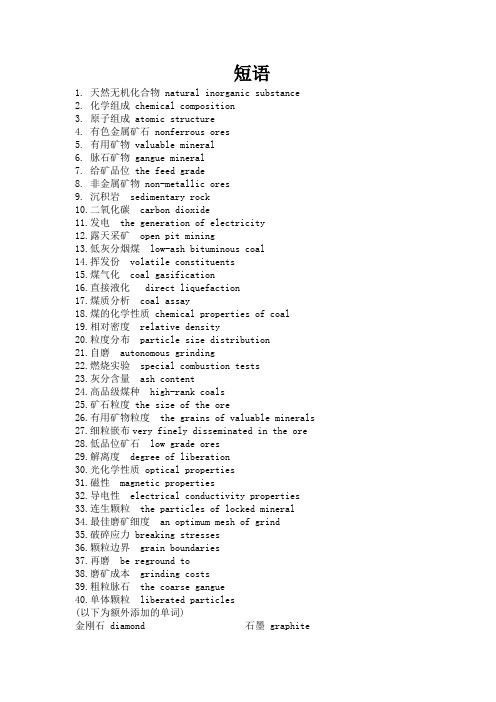
短语1.天然无机化合物 natural inorganic substance2.化学组成 chemical composition3.原子组成 atomic structure4.有色金属矿石 nonferrous ores5.有用矿物 valuable mineral6.脉石矿物 gangue mineral7.给矿品位 the feed grade8.非金属矿物 non-metallic ores9.沉积岩 sedimentary rock10.二氧化碳 carbon dioxide11.发电 the generation of electricity12.露天采矿 open pit mining13.低灰分烟煤 low-ash bituminous coal14.挥发份 volatile constituents15.煤气化 coal gasification16.直接液化 direct liquefaction17.煤质分析 coal assay18.煤的化学性质 chemical properties of coal19.相对密度 relative density20.粒度分布 particle size distribution21.自磨 autonomous grinding22.燃烧实验 special combustion tests23.灰分含量 ash content24.高品级煤种 high-rank coals25.矿石粒度 the size of the ore26.有用矿物粒度 the grains of valuable minerals27.细粒嵌布very finely disseminated in the ore28.低品位矿石 low grade ores29.解离度 degree of liberation30.光化学性质 optical properties31.磁性 magnetic properties32.导电性 electrical conductivity properties33.连生颗粒 the particles of locked mineral34.最佳磨矿细度 an optimum mesh of grind35.破碎应力 breaking stresses36.颗粒边界 grain boundaries37.再磨 be reground to38.磨矿成本 grinding costs39.粗粒脉石 the coarse gangue40.单体颗粒 liberated particles(以下为额外添加的单词)金刚石 diamond 石墨 graphite原矿石 run-of-mine ore 维护成本 maintenance costs强加于 imposes on 驱动轴 drive shaft相对于 relative to 把...固定在...上 attachment to矿物加工方法 Mineral processing methods粉碎原理 Principles of comminution解离 liberation 富集 concentration选择1.gold and platinum D(native or metallic form)2.most of mineral A(their composition)3.two minerals that B(quite different physical properties)4.granite is composed A(different)P171、they are release or liberation2、which is called concentration3、which involves crushing and sometimes grinding4、Over-grinding is wasteful5、some specific difference in physical or chemical properties between the valuable and gangue6、such as sizing of the ore and dewatering of the mineral pulps英译汉1、The abundance of metals in the ocean is related to some extent to the crustal abundancies , since they have come from the weathering of the crustal rocks. 海洋中蕴含丰富的金属,在某种程度上与地壳的丰度有关,因为这些金属来自于地壳岩石的风化作用。
矿物加工专业英语词汇1——术语

M-曲线
3.2.14
灰分/相对密度曲线
Ash/relative density curve
根据浮沉试验结果绘制的,表示逐个密度级的灰分与相应的平均相对密度级之间关系的曲线。
3.3
能力与处理量
Capacity and throughput
作业能力
3.3.03
设计能力
Design capacity
在特定给料性质范围内,能满足或达到要求性能和指标的前提下,选煤厂各专用设备连续运转时的给料量。
3.3.04
最大设计能力
Peak design capacity
在不能满足或达到要求性能和指标的前提下,选煤厂各专用设备在短时间内所能承受的,超过设计能力的给料量。
厂址设在矿区范围以外独立的工业场地上,入选外来毛(原)煤的选煤厂。
中央洗煤厂、集中洗煤厂
编号
术语名称
英文名称
定义或说明
代号
允许使用的同义词
禁止使用的同义词
3.3.18
用户洗煤厂
User’s coal preparation plant
厂址设在用户(如焦化厂等)工业场地的选煤厂。
3.3.19
分选作业
Separation process
编号
术语名称
英文名称
定义或说明
代号
允许使用的同义词
禁止使用的同义词
3.3.32
洁净煤技术
Clean coal technology
在煤炭开发和利用过程中旨在减少污染与提高利用效率的加工、燃烧、转化及污染控制等新技术。
矿物加工专业英语
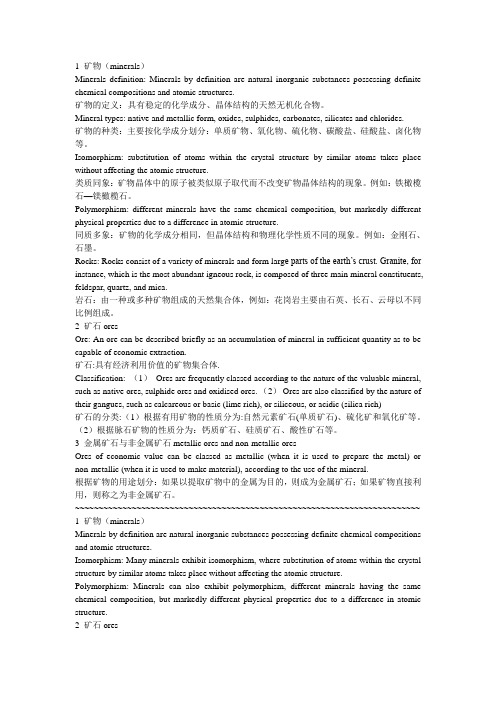
1 矿物(minerals)Minerals definition: Minerals by definition are natural inorganic substances possessing definite chemical compositions and atomic structures.矿物的定义:具有稳定的化学成分、晶体结构的天然无机化合物。
Mineral types: native and metallic form, oxides, sulphides, carbonates, silicates and chlorides.矿物的种类:主要按化学成分划分:单质矿物、氧化物、硫化物、碳酸盐、硅酸盐、卤化物等。
Isomorphism: substitution of atoms within the crystal structure by similar atoms takes place without affecting the atomic structure.类质同象:矿物晶体中的原子被类似原子取代而不改变矿物晶体结构的现象。
例如:铁橄榄石—镁橄榄石。
Polymorphism: different minerals have the same chemical composition, but markedly different physical properties due to a difference in atomic structure.同质多象:矿物的化学成分相同,但晶体结构和物理化学性质不同的现象。
例如:金刚石、石墨。
Rocks: Rocks consist of a variety of minerals and form larg e parts of the earth’s crust. Granite, for instance, which is the most abundant igneous rock, is composed of three main mineral constituents, feldspar, quartz, and mica.岩石:由一种或多种矿物组成的天然集合体,例如:花岗岩主要由石英、长石、云母以不同比例组成。
矿物加工专业英语词汇

矿物加工专业英语词汇————————————————————————————————作者:————————————————————————————————日期:ﻩ矿物加工专业英语词汇(一)基本词汇1选矿-Mineral seperation(oredressing) 2设计-Design3工艺-Technics(craftwork) 4初步设计-Initiative(preliminary)desi gn5流程-Flow(circuit) 6流程图-flowchart7施工设计-workingdesign8设计方案-design project9粉碎-comminution 10 磨矿-grinding11浮选-flotation 12脱水-dehydration13干燥车间-drying shop14尾矿-tailing15精矿-concentrate 16中矿-middles17精选-concentration18粗选-first concentration20选矿机-concentrator 21矿浆orepulp22分级-classification 22磨矿-grinding23磨矿机-grinding mills24筛分-screen25粉碎-crush26筛分机-screener27粉碎机-crusher 28颚式粉碎机-jawcrusher29圆锥粉碎机-conecrusher 30冲击式粉碎机impact crusher31辊式粉碎机-crusherrolls32球磨机-ball mill33棒磨机-rodmill34自磨机-autogenousmills35震动筛-vibratoryscreener36分级机-classificationequipment37浮选-flotation38浮选机-flotation equipment39重选-reelect 40特殊选-special selection41 浮选柱-flotationploe42脱水机-spin-drier43干燥机-drier44总图-general chart45配置-deploy 46运输-transport47环境保护-environmentprotect 48场址-fieldlocation(site)49布置-lay 50设计资料-design information51粉碎流程-comminutionflow 52磨矿流程-grinding flow(circuit)53浮选流程-flotation flow54金属矿-metallic mines55非金属矿-non-metallicmines56闭路-closecircuit(loop)57闭路流程-closeflow 58开路-cut circuit(loop)59开路流程-cut flow60废水-liquid waste61粉尘-powder62噪声-yawp63污染-contamination 64沉淀-formsediment65净化-decontaminate 66输送-transportation67矿石-ore 68物料-material69给矿-feed ores 70给料-feedstuff71设备-equipment72方案-project73标高-elevation 74通道-passage75维修-maintain 76检查-check77操作-operation78化验-test、assay79检测-examine80坡度-gradient81起重机-crane 82堆积-accumulation83细粒-granule、fine 84粗粒-coarse85尾矿坝-tailing dam86矿仓-feed bin(storehouse)87粉矿仓-crushing pocket88产品仓-productbin(storehouse) 89砂泵-pump 90立式泵-stand pump91卧式泵-horizontal pump92耐酸泵-acid-proof pump93耐碱泵-alkali-resistantpump94勘察-reconnaissance95地形-landform96工程-engineering97设计步骤design process 98规模-scale99选矿厂-concentrating mill100设计内容designcontent (二)磨矿筛分1 comminution-粉碎2comminutionengineering-粉碎工程3粉碎机-comminuter4粉碎动力学-comminution kinetics5筛分曲线图-screen analysischart6筛孔-screen aperture7筛面-screen area8筛条screenbar9筛框-screen box 10筛选厂-screenbuilding11筛分机生产能力screencapacity 12筛分槽-screen cell13筛布-screen cloth 14筛分screen classification15筛孔-screen hole 16筛分车间-screenhouse17筛分分析-screen analysis 18滚筒筛-screening-drum19筛分效率-screening efficiency20筛分速率-screeningrate21筛网-screen mesh 22筛制、筛比、筛序-screen scale23筛孔尺寸-screensize24套筛-screen set25筛序-screen size gradation26筛余物screentailings27筛下产品-screen throughs(underflow.undersize) 28可碎性crushability 29可碎性系数-crushability factor 30碎矿仓-crushed ore pocket31粉碎产品-crushed product32粉碎粒度-crusher size33粉碎腔-crushing cavity 34粉碎厂-crushing plant35粉碎系数-crushing coefficient 36粉碎工段-crushiong section37助磨剂-grinding aid38磨球-grinding ball39 磨矿负荷-grindingcharge40磨矿效率-grinding efficiency41磨矿-grinding ore42磨砾-grindingpebble43磨碎能力-grinding property44研磨试验grinding test45磨矿设备-grinding unit46磨矿速度-grinding rate47磨矿功率-grinding power48磨矿车间-grinding plant49可磨性-grindability 50可磨性指数-grindability index51可磨性指标-grindability rating 52可磨性试验-grindability test53研磨工-grinder 54磨工车间-grindery55磨矿动力学-grinding kinetics 56粉碎能-crushing energy57粉碎机给矿口-crushing mouth58粉碎面-crushingface59粉碎力-crushingforce 60粉碎机进料口-crusherthroat61筛分动力学-screenkinetics 62选厂矿仓-mill bin63选厂中矿mill chats64选厂配置mill configuration65磨过的矿石-milled ore 66磨机给料-mill feeder67选厂给矿-mill-head68研磨作用-millingaction 69磨机衬里mill liner70入选品位milling grade71入选品位矿石milling-grade ore 72磨矿机milling-grinder73细碎、精磨-millinggrinding 74磨矿介质-milling medium75磨矿法-milling method76选矿作业-milling operation77选矿厂-milling plant78选厂矿泥-milling slime79选厂厂址-millsite 80磨机负荷-mill load81选矿工(工长)millan82磨机需用功率-millpower draft 83选矿质量控制millpualitycontrol84选矿取样-mill sampling85磨机外壳-mill shell86磨机矿浆-mill slurries87磨石-millstone88选矿厂储矿仓mill-storage89选厂尾矿-mill tail 90选矿用水-mill water91磨矿机溶液-millsolution 92选矿厂建筑师-millwright93分级沉淀-class setting 94矿粉-mineral fine95分级-classification96分级溢流-classifieroverflow 97分级返砂-classifier sand98分级机-classifier99分级筛-classifying screen100分级箱-classifyingbox(三)流程设备1品位-grade 2精矿品位-concentrategrade3尾矿品位-tailinggrade 4尾矿场-tail area(pile)5尾矿仓-tailingbin6尾矿滤饼-tailing cake7尾矿坝-tailing dam8尾矿池-tailingpond(pit) 9取样-taking cut(sampling)10滑石talc11蓝晶石-talc blue12 试样缩分-sample division13 分样器-sampledivider14精矿取样-concentrate sampling 15中矿取样-middlessampling 16尾矿取样-tailingsampling 17浓缩-thickening18精矿浓缩-concentrate thickening 19选矿流程-concentratingcircuit 20精选机-concentrating mcching 21试样缩分-sample reduction (splitting) 22矿物组成-mineralcomposition23矿物组分-mineral constituent 24矿床-mineral depost25矿物-mineral 26选矿方法mineraldressing method27选矿厂-concentratingmill28选矿ore dressing,mineral separation29矿物分析-mineral analysis 30矿物组合-mineral association31试样袋-sample sack 32矿床-deposit33矿物岩相facies34矿物纤维-mineralfiber35固、气界面-mineral-airinterface36固、液界面-mineral-water interface 37固、气、液接触mineral-air-watercontact 38矿物颗粒-grain39矿物鉴定-mineral identification 40矿物资源-interest41矿物解离-mineralliberation 42矿物特性mineral character43矿物储量-mineral reserve 44矿物(成分)检验mineral logical e xamination45扑收剂-Minerec,flotigan,46精矿回收率concentrate recovery47中矿回收率middles recovery48精选concentration49附着精矿气泡concentratr-loaded bubble50精选机-concentratingmaching 51分选判据-concentration criterion52富集比-concentration factor53选矿摇床-concentration table 54选厂流程concentrator flow5选厂流程图concentratorflow sheet 56试样品位-sample grade57絮凝剂-flocculant58絮凝-floculate59絮凝物-flocs 60絮凝浮选floc flotation61絮凝作用flocculation---> agglomerate粘结剂,凝结剂Coagulation凝聚‹凝聚(Coagulation)指胶体被压缩双电层而脱稳的过程;‹ 絮凝(Flocculation)指胶体由于高分子聚合物的吸附架桥作用而聚集62浮选机flotation unit63浮选剂-flotation agent64整排浮选机flotationbank65浮选槽- flotationcell 66浮选能力flotationcapacity67浮选精矿- flotation concentrate68浮选尾矿flotationrejects69浮选中矿- flotationmiddles 70浮选设备flotationequipment71浮选泡沫-flotation froth72浮选动力学flotationkinetics73浮选浸出法-flotationleachingmethod74浮选厂flotationmill75浮选油-flotation oil76浮选矿浆- flotation pulp77浮选速度-flotation rate78浮选试验flotationtest79单槽浮选机- flotation unitcell 80浮选摇床- flotationtable81摇床浮选- flotation tabling 82起泡剂Flotol83流程图-flow line84工艺流程图-flow process chart (flow sheet)85可选(洗)性-washability 86可选性特性- washability characterist ic87可选性曲线- washabilitycurve 88可选性指数- washability number89可选性试验- washability test 90可浮性-flotability91可浮性曲线-flotability curve 92粒度特性-granularity93粒度分级试验gradingtest 94结构-texture95构造-tectonic(structural)96致密结构-compacttexture97斑状结构porphyritictexture 98 粒度分析-granularmetricanalysis99采样-sample collecting 100分样器-sampledivider《磁电选矿部分)英文词汇MineralProcessingTechnology 矿物加工工艺学Principleof magnetismprocess 磁选原理Magnetic force磁力Ratiomagneticforce 比磁力Compete force竞争力Mineralmagnetism 矿物的磁性Atomic magnetism moment原子磁矩Molecularmagnetism moment 分子磁矩Magnetization & magnetic field 磁化和磁化磁场Magnetization intensity 磁化强度Ratiosusceptibility 比磁化系数Diamagnetism 逆磁性Paramagnetism顺磁性Ferromagnetism 铁磁性Magneticdomain磁畴Revers ferromagnetism反铁磁性Subferromagnetism 亚铁磁性Coercive force矫顽力Remanence剩磁Magnetization roasting磁化焙烧Deoxidization roasting 还原焙烧Midlle roasting 中性焙烧Oxidationroasting氧化焙烧Siderite 菱铁矿Hematite 赤铁矿Magnetite 磁铁矿Unhydrophitemagnetization 疏水磁化Magneticprocess equipment磁选设备Feeblenessmagneticseparation machine弱磁场磁选机Drymagnetic separationmachine 干式磁选机Wet feeblenessmagnetic separation machine 湿式弱磁场磁选机High magneticseparation machine强磁场磁选机High grads magnetic sparationmachine 高梯度磁选机Supercondduct magnetic separation 超导电选Concentrator选矿机Electrity process电选Electrity concentrator 电选机Static separation 静电选矿Air-ionization separation电晕分选Frictionelectricseparation 摩擦电选Magnetic process practice磁选实践Nonmetal ore 非金属矿Diamond process 金刚石选矿Heavymedium reclaim 重介质回收Primary concentrate 粗精矿Graphite gangue石墨尾矿Kaolin magneticprocess高岭土磁选Blockmetal ore 黑色金属矿石Manganese oremagneticprocess锰矿石磁选Coloured metal & rare metal 有色金属和稀有金属Ilmenite 钛铁矿Rutile金红石Zircon 锆英石Electric processpractice 电选实践Tungstate钨酸盐cassiterite 锡石hematite.赤铁矿gangue脉石,废石,矸石magnet.磁铁,磁体,磁石conductor mineral 导体矿物silicate 硅酸盐diatomite 硅藻土hysteresis 磁滞现象magneticcore .磁铁芯winding 绕组,线圈medium介质electrophoresis 电泳screening 筛分magnetic field 磁场flux磁通量ferromagnet铁磁物质ferromagnetism 铁磁性reunite 团聚magnetic system磁系magneticagitate 磁搅动permanent magnet 永久磁铁solenoid magnet 螺管式磁铁pyrite.黄铁矿,硫铁矿limonite褐铁矿reluctivity 磁阻率conduct传导induce.诱导,感应,归纳astrict束缚charge电荷electric field .电场interfacial界面的,面间的magnetism 吸引力electrode 电极,电焊条,电极Strontium&iron oxid锶铁氧体Periodic magnetic field交变磁场Pulsant magnetic field 脉动磁场Saturation饱和stainless steel material 不锈钢材料polar distance 极距mica云母quarte石英stimulatemagnetism激磁magnetism circuit 磁路magneticline offorce磁力线commutatequality 整流性(重选部分)英文词汇(1)gravity concentration 重力选矿(2)Abkhazite 透闪石棉(3)Amiantus 石棉(4)acceptance operation 矿石预选(5)Acclivity 斜面(6)airborne dust大气浮尘(7)airconveying风力输送(8)amplitude of vibration 振幅(9)ancillary mineral 伴生矿物(10)apparent viscosity视粘度(11)artificial bedding 人工床层(12)attle 废石(13)average graindiameter平均粒径(14)axialmotion轴向运动(15)backwash water 冲洗水(16)backwater筛下水(17)barite菱镁蛇纹岩(18)barren rock 脉石(19)beachore 砂矿(20)bedseparation 分层(21)bevel angle 倾斜角(22)buddle淘洗盘(23)buddle jig 动筛跳汰机(24)buoyancy 浮力(25)buoyant weight 悬浮重量(26)Caplastometer粘度计(27)Centipoises厘泊(28)Centrifugal field 离心力场(29)Centrifugal jig离心跳汰机(30)Circular 圆形跳汰机(31)Centrifuge离心机(32)Classificationefficiency 分级效率(33)Classifier分级机(34)Classifier overflow分级机溢流(35)Classifier sand 分级机返砂(36)Close sizing窄级分级(37)Claster ofparticles颗粒群(38)Coarsefeed粗粒给料(39)Cyclone 水力旋流器(40)Cassiterite 锡石(41)Dilated松散床层(42)dimensionlessparameter无因次参数(43)duplextable双层摇床(44)diaphragmjig隔膜跳汰机(45)dwindles out 尖灭(46)filmconcentration流膜选矿(47)finalvelocity 末速度(48)free settling particle 自由沉降颗粒(49)free settlingratio 自由沉降比(50)gravity concentrate重选精矿(51)gravity tailings重选尾矿(52)galena 方铅矿(53)iron orepellet 铁矿球团(54)jig cycle 跳汰周期(55)heavy liquid 重液(56)heavy-media separator重介质分选(57)heavy-media suspension重介质悬浮液(58)hydraulic analysis 水力分析(59)high-weirspiral classifier 高堰式螺旋分级机(60)hindered settling 干涉沉降(61)HMS-flotation method重介质浮选联合分选(62)Hydrocyclone 水力旋流器(63)Laundering溜槽选矿(64)low- weir spiral classier低堰式螺旋分级机(65)medium recovery screen介质回收筛(66)meerschaum 海泡石(67)menachanite 钛铁砂(68)outervortex外螺旋线(69)particle diameter 颗粒直径(70)particle shape 颗粒形状(71)particlesize accumulation 粒度累积曲线(72)partition size 分离粒度(73)jigging 跳汰选矿(74)regenerated dense medium重介质再生(75)sand table 矿砂摇床(76)scalping screen脱介筛(77)setting vessel沉降速度(78)shaking table 摇床(79)sieve compartment 筛网室(80)simplex spiral 单螺旋分级机(81)sinusoidal wave单层摇床(82)sizing analysis 粒度分析(83)silica 硅石(84)spherical particle球形颗粒(85)spheroid 似球形(86)spindle 针状形(87)spiral chute螺旋溜槽(88)spiral concentrator 螺旋选矿机(89)stiction静摩擦(90)submerged spiral type classifler 沉没式分级机(91)suction bailer吸入作用(92)table 摇床(93)table riffle 摇床格条(94)table circuit摇床流程(95)table tailing 摇床尾矿(96)table flotation 台浮(97)talcum 滑石(98)taraspite白云石(99)wedgeangle 锥角(100) weight重力(浮选部分)英文词汇floatation 浮选froth flotation 泡沫浮选direct flotation 正浮选reverse flotation反浮选fineness ofgrinding 磨矿细度fractionation 分级mineral wettability矿物润湿性mineralflotability 矿物的可浮性equilibrium contactangle平衡接触角three phase interface三相界面hydrophobicity of mineral矿物的疏水性hydrophilicityof mineral 矿物的亲水性foam adhesion泡沫附着ionic lattice 离子晶格covalence lattice共价晶格surface inhomogeneity 表面的不均匀性oxidationand dissolution氧化与溶解oxidizing agent氧化剂reduction agent还原剂surface modification of mineral 矿物的表面改性electric double layer 双电层ionization 电离adsorption吸附electrokineticpotential电动电位point of zero charge 零电点isoelectric point 等电点collecting agent捕收剂semi micelle adsorption半胶束吸附exchangeadsorption交换吸附competitiveadsorption竞争吸附specificadsorption特性吸附modifyingagent 调整剂depressant抑制剂activatingagent活化剂foaming agent起泡剂hydrophilicgroup亲水基团liberation degree 解离度polar group 极性基团nonpolargroup非极性基团sulphideore 硫化矿物oxidizedmineral 氧化矿物xanthate 黄药hydrolysis 水解medicamentous selectivity药剂的选择性catchmentaction捕收作用electrochemicalaction电化学作用pyrite 黄铁矿calcite 方解石alkylradical 烃基含氧酸organic amine 有机胺类carboxylate surfactant羧酸盐kerosene煤油amphoteric collector 两性两捕收剂alkyl radical sulfonate烃基磺酸盐complex 络合物PHmodifyingagent PH调整剂long-chain molecule长链分子chalcopyrite 黄铜矿galena 方铅矿blende闪锌矿oxidized ore氧化矿flocculant 絮凝剂non-hydronium flocculant 非离子型絮凝剂desorption解吸airbladder 气泡solubility 溶解度specific surface area 比表面积mineral resources 矿源threephase air bladder三相气泡ore magma electric potential矿浆电位mixed potential model混合电位模型freedomhydrocarbon diversification 自由烃变化electrostatic pull 静电引力intermolecular force分子间力goethite针铁矿semi micelle adsorption半胶束吸附concentration ofsolution溶液浓度flotation machine浮选机oxygenation 充气作用recovery 回收率concentrate grade 精矿品位handling capacity 处理能力air bladder collision气泡碰撞flotation column 浮选柱oreconcentration dressing 富集作用floatationprocess 浮选工艺floatationspeed浮选速率flotationcircuit 浮选流程granularity粒度degree of fineness细度pulp density 矿浆浓度waterquality 水质backwater 回水middlings中矿run of mine原矿gangue 尾矿flotationprinciple flow浮选原则流程rate ofdivergence 分散程度dispersant 分散剂semiconductivityofmineral矿物半导性reagent removal agent 脱药剂Flotation reagent professional words Absorption 吸收Absorption band 吸收光谱带Abstract抽出,提取Abundance丰富,丰度Accelerant 促进剂Acceptance验收,接收Accumulate积累,聚集Accuracy 准确度Acctate 醋酸盐Acctamide 乙酰胺Acid酸,酸的Acidanion 酸性阴离子Acidation 酸化Acid depression 加酸抑制Acid hydrolysis 加酸水解Acintol妥尔油制品Acrylic amide丙烯酰胺Activate 活化Activated adsorption活性吸附Activatedmolecule 活化分子Activated effect活化作用Activator 活化剂,活性剂Acto精制石油磺酸钠Acylamide酰胺Addition 加添Adhere粘附,附着Adhesioncoefficient粘着系数Adhesive粘合剂Adhesive tension胶结张力界面吸引力Adion 吸附离子Adsorbate 吸附物Adsorbent吸附剂Adsorptionisotherm吸附等温线Adsorptionlayer吸附层Aero美国氰胺公司的药剂品牌号Aerofloat 美国氰胺公司的黑药牌号Aerofloc 絮凝剂牌号Aerofroth 起泡剂牌号Aeromine 阳离子型表面活性剂Aero promoter促进剂牌号Aerosol 润湿剂牌号AerosurfMG-98A 醚胺醋酸盐Agglomerant团聚的凝结剂Agglomeration flotation团聚浮选Aggregateoflarge molecules大分子团Aiv-avid亲气的Aiv-mineral adhesion空气-矿物粘附Alamine胺的牌号Alcohol醇Alcohol frother醇类起泡剂Aliphat- 妥尔油脂肪酸牌号Aliphatic alcohol脂肪醇Aliphatic acid 脂肪酸Aliphatic amine脂肪胺Aliphatic dydrocarbon脂肪烃Aliquat苯胺盐牌号Alkali 碱Alkaliuity 碱度,碱性Alkane链烷,烷烃Alkoxy- 烷氧基Alkoxyamine 烷氧胺Alkoxy benzene烷氧基苯Alkyl- 烷基Alkyl alcoholsulfate 烷基醇硫酸盐Alkylamine 脂肪胺Alkylarsonic acid烷基砷酸Alkylarylsulfonate 烷基芳基磺酸盐Aldylhydroxamic acid烷基羟污酸Alkylphosphate 烷基磷酸盐Alkyl sodiumsulfonate烷基磺酸钠All-flotation approach 全浮处理法Allowance 允许,公差All-purpose通用的Amine 胺的牌号Amino-acid氨基酸Ammonia 氨Amphateric 两性的Amphoteric surfactant两性表面活性剂Amylum淀粉Analysis分析Angle角,角度Anion阴离子Anion collector 捕收剂Anode 阳极,正极Anti-corrosivecoating 防腐浮层Antifoamer消泡剂Apparent hardness 表现硬度Applicability活用性,适应性Aqua ion水合离子Aquation水合作用Armeen 胺的牌号ArosurfMG醚胺的牌号Affached bubble粘附气泡Bagolax 甲基纤维素Barrett 煤焦杂酚油牌号Benzyl alcohol苯甲醇Bromoform 溴仿,三溴甲烷Bubble 气泡,泡沫Bubbler气泡器Butyl 丁基Butyl aerofoat丁基黑药Calcium oxide氧化钙Capillary 毛细管,毛细作用Carbitol 卡必醇Carbohydrate碳水化合物Cation 阳离子Cationiccollector阳离子捕收Cellulosice CMC 羧甲基纤维素Charge电荷,充电Chelate 螯合物Chelate effect 螯合效应Chelationgroup 螯合基团Chemicaladsorption 化学吸附Chemicalore processing 化学选矿Chloro acetic acid 氯乙酸Cohesion粘结力凝聚力Collector 捕收剂Colloid胶体Creosote oil杂酚油Critical PHvalue 临界PH值Concentrate grade精矿品位Concentration 精选、富集Cyanide氰化物Daxad 烷基磺酸钠Deflocculator 反絮凝剂Defoamer消泡剂Dehydratingagent 脱水剂Dehydrogenation脱氧Delamine 妥尔油胺Dense liqued 重液Depressant抑制剂Desorbent解吸剂Deslimie脱泥Desludging agent脱泥剂Dicarboxylic acid二羟酸Dodecylamine十二胺,月桂胺Dodecylalcohol十二烷醇Dodecyl amine-hydrochloride十二胺盐酸盐Dresinate松脂酸皂捕收剂Dual cleaning 二重精选Duponol 烷基硫酸钠牌号Dust-allaying medium防尘剂Dynamic balance 动态平衡Efficiency效率,功效Electrochemical approach 电化学处理法Electro-kineticpotential动电势Electrostaticattraction静电吸引Emulsifying agent乳化剂Extract提取,萃取Ferricsulfate 硫酸铁补充aqueous 水的;水状的;水成的。
矿物加工专业英语词汇3——分选
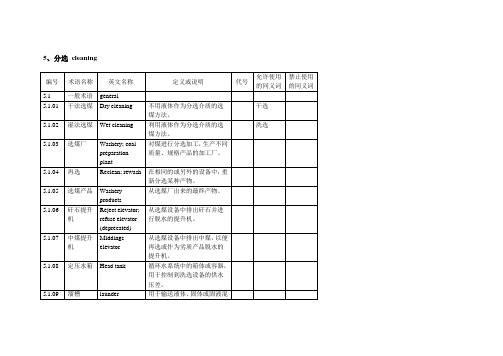
摩擦选煤
Friction cleaning
利用矿物沿倾斜面运动时摩擦系数的差别,实现分选的选煤方法。
5.1.32
主选
Primary cleaning
对原煤进行分选的作业。
主洗
5.1.33
中间产物
Intermediate product
尚需继续分选的非最终产物。
5.1.34
回选
Recirculation cleaning
二段排矸提升机
Secondary rejectFra bibliotekelevator
通常设在跳汰机的溢流端、排运第一段重物料的提升机。
5.3.31
冲水
Top water; transport water
与原料煤一同给入分选设备中,主要起输送和湿润作用的水。
5.3.32
输送水
flushing water
用来帮助物料在溜槽中流动所加的水。
5.3.13
跳汰机筛下室
hutch
跳汰机筛板以下的机体部分,由此实现控制水的脉冲运动。
5.3.14
跳汰机入料堰
Jig feed sill
入料进入跳汰机时所越过的跳汰机部件。
5.3.15
跳汰机中间堰
Jig center weir
位于跳汰机入料端和溢流端之间的一个可调隔板,用以调节跳汰机物料向前的运动。
5.3.10
跳汰床层
Jig bed
跳汰机筛板承托的全部物料。
5.3.11
跳汰分室
Jig cell
跳汰机筛板之下用横隔板分开的单独区间,每一区间都独立调节风或水。
5.3.12
跳汰分段
Jig compartments
矿物加工工程专业英语词汇知识交流
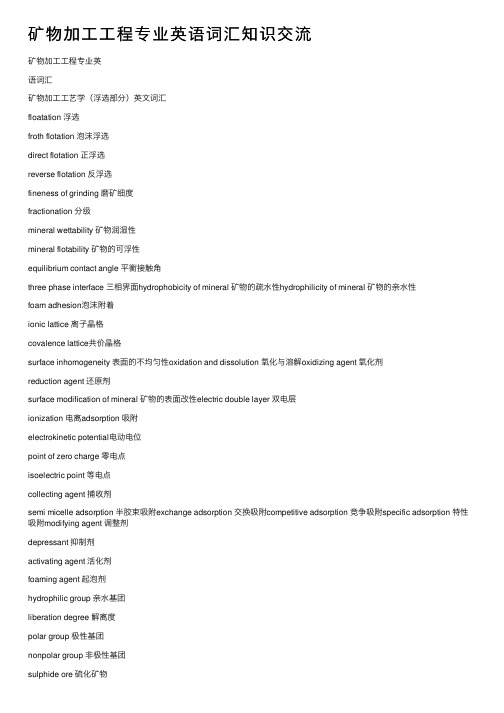
矿物加⼯⼯程专业英语词汇知识交流矿物加⼯⼯程专业英语词汇矿物加⼯⼯艺学(浮选部分)英⽂词汇floatation 浮选froth flotation 泡沫浮选direct flotation 正浮选reverse flotation 反浮选fineness of grinding 磨矿细度fractionation 分级mineral wettability 矿物润湿性mineral flotability 矿物的可浮性equilibrium contact angle 平衡接触⾓three phase interface 三相界⾯hydrophobicity of mineral 矿物的疏⽔性hydrophilicity of mineral 矿物的亲⽔性foam adhesion泡沫附着ionic lattice 离⼦晶格covalence lattice共价晶格surface inhomogeneity 表⾯的不均匀性oxidation and dissolution 氧化与溶解oxidizing agent 氧化剂reduction agent 还原剂surface modification of mineral 矿物的表⾯改性electric double layer 双电层ionization 电离adsorption 吸附electrokinetic potential电动电位point of zero charge 零电点isoelectric point 等电点collecting agent 捕收剂semi micelle adsorption 半胶束吸附exchange adsorption 交换吸附competitive adsorption 竞争吸附specific adsorption 特性吸附modifying agent 调整剂depressant 抑制剂activating agent 活化剂foaming agent 起泡剂hydrophilic group 亲⽔基团liberation degree 解离度polar group 极性基团nonpolar group ⾮极性基团sulphide ore 硫化矿物oxidized mineral 氧化矿物xanthate 黄药hydrolysis ⽔解medicamentous selectivity药剂的选择性仅供学习与交流,如有侵权请联系⽹站删除谢谢2仅供学习与交流,如有侵权请联系⽹站删除谢谢3仅供学习与交流,如有侵权请联系⽹站删除谢谢4矿物加⼯⼯艺学(重选部分)英⽂词汇gravity concentration 重⼒选矿 Abkhazite 透闪⽯棉 Amiantus ⽯棉 acceptance operation 矿⽯预选 Acclivity 斜⾯airborne dust ⼤⽓浮尘 air conveying 风⼒输送 amplitude of vibration 振幅 ancillary mineral 伴⽣矿物 apparent viscosity 视粘度 artificial bedding ⼈⼯床层 attle 废⽯average grain diameter 平均粒径 axial motion 轴向运动 backwash water 冲洗⽔ backwater 筛下⽔barite 菱镁蛇纹岩 barren rock 脉⽯ beach ore 砂矿 bed separation 分层 bevel angle 倾斜⾓ buddle 淘洗盘 buddle jig 动筛跳汰机 buoyancy 浮⼒buoyant weight 悬浮重量 Caplastometer 粘度计 Centipoises 厘泊 Centrifugal field 离⼼⼒场 Centrifugal jig 离⼼跳汰机Circular 圆形跳汰机 Centrifuge 离⼼机Classification efficiency 分级效率仅供学习与交流,如有侵权请联系⽹站删除谢谢5仅供学习与交流,如有侵权请联系⽹站删除谢谢6矿物加⼯⼯艺学(磁电选矿部分)英⽂词汇Mineral Processing Technology 矿物加⼯⼯艺学Principle of magnetism process 磁选原理 Magnetic force 磁⼒ Ratio magnetic force ⽐磁⼒ Compete force 竞争⼒ Mineral magnetism 矿物的磁性 Atomic magnetism moment 原⼦磁矩 Molecular magnetism moment 分⼦磁矩 Magnetization & magnetic field 磁化和磁化磁场Magnetization intensity 磁化强度 Ratio susceptibility ⽐磁化系数 Diamagnetism 逆磁性 Paramagnetism 顺磁性Ferromagnetism 铁磁性 Magnetic domain 磁畴 Revers ferromagnetism 反铁磁性 Subferromagnetism 亚铁磁性 Coercive force 矫顽⼒ Remanence 剩磁Magnetization roasting 磁化焙烧Deoxidization roasting 还原焙烧Midlle roasting 中性焙烧Oxidation roasting 氧化焙烧Siderite 菱铁矿Hematite ⾚铁矿Magnetite 磁铁矿Unhydrophite magnetization 疏⽔磁化Magnetic process equipment 磁选设备Feebleness magnetic separation machine 弱磁场磁选机Dry magnetic separation machine ⼲式磁选机Wet feebleness magnetic separation machine 湿式弱磁场磁选机High magnetic separation machine 强磁场磁选机High grads magnetic sparation machine ⾼梯度磁选机Supercondduct magnetic separation 超导电选Concentrator 选矿机Electrity process 电选Electrity concentrator 电选机Static separation 静电选矿Air-ionization separation 电晕分选Friction electric separation 摩擦电选Magnetic process practice 磁选实践Nonmetal ore ⾮⾦属矿Diamond process ⾦刚⽯选矿Heavy medium reclaim 重介质回收Primary concentrate 粗精矿Graphite gangue ⽯墨尾矿Kaolin magnetic process ⾼岭⼟磁选Block metal ore ⿊⾊⾦属矿⽯Manganese ore magnetic process 锰矿⽯磁选Coloured metal & rare metal 有⾊⾦属和稀有⾦属Ilmenite 钛铁矿Rutile ⾦红⽯Zircon 锆英⽯Electric process practice 电选实践Tungstate 钨酸盐cassiterite 锡⽯hematite ⾚铁矿gangue 脉⽯,废⽯,矸⽯magnet 磁铁,磁体,磁⽯conductor mineral 导体矿物silicate 硅酸盐diatomite 硅藻⼟仅供学习与交流,如有侵权请联系⽹站删除谢谢7hysteresis 磁滞现象magnetic core . 磁铁芯winding 绕组,线圈medium 介质electrophoresis 电泳screening 筛分magnetic field 磁场flux 磁通量ferromagnet 铁磁物质ferromagnetism 铁磁性reunite 团聚magnetic system 磁系magnetic agitate 磁搅动permanent magnet 永久磁铁solenoid magnet 螺管式磁铁pyrite 黄铁矿,硫铁矿limonite 褐铁矿reluctivity 磁阻率conduct 传导induce 诱导,感应,归纳astrict 束缚charge 电荷electric field .电场interfacial 界⾯的,⾯间的magnetism 吸引⼒electrode 电极,电焊条,电极Strontium & iron oxid 锶铁氧体Periodic magnetic field 交变磁场Pulsant magnetic field 脉动磁场Saturation 饱和stainless steel material 不锈钢材料polar distance 极距mica 云母quarte ⽯英stimulate magnetism 激磁magnetism circuit 磁路magnetic line of force 磁⼒线commutate quality 整流性Flatation reagent professional wordsAbsorption 吸收Absorption band 吸收光谱带Abstract 抽出,提取Abundance 丰富,丰度Accelerant 促进剂Acceptance 验收,接收仅供学习与交流,如有侵权请联系⽹站删除谢谢8仅供学习与交流,如有侵权请联系⽹站删除谢谢9仅供学习与交流,如有侵权请联系⽹站删除谢谢10仅供学习与交流,如有侵权请联系⽹站删除谢谢11仅供学习与交流,如有侵权请联系⽹站删除谢谢12 矿物加⼯⼯艺常⽤词汇(⼀)1选矿-Mineral separation (ore dressing) 2设计-Design3⼯艺-Process (craftwork)4初步设计-Initiative(preliminary) design 5流程-Flow(circuit)6流程图-flowsheet7施⼯设计-working design8设计⽅案-design project9粉碎-comminution10 磨矿-grinding11浮选-flotation12脱⽔-dehydration13⼲燥车间-drying shop14尾矿-tailing15精矿-concentrate16中矿-middles17精选-concentration 18粗选-first concentration20选矿机-concentrator 21矿浆ore pulp22分级-classification22磨矿-grinding23磨矿机-grinding mills24筛分-screen25粉碎-crush26筛分机-screener27粉碎机-crusher28颚式粉碎机-jaw crusher29圆锥粉碎机-cone crusher 30冲击式粉碎机impact crusher 31辊式粉碎机-crusher rolls 32球磨机-ball mill33棒磨机-rod mill34⾃磨机-autogenous mills35震动筛-vibratory screener36分级机-classification equipment 37浮选-flotation38浮选机-flotation equipment39重选- gravity concentration 40特殊选-special selection41 浮选柱-flotation column 42脱⽔机-spin-drier43⼲燥机-drier44总图-general chart45配置-deploy46运输-transport47环境保护-environment protect 48场址-field location(site)49布置-lay50设计资料-design information 51粉碎流程-comminution flow 52磨矿流程-grinding flow(circuit) 53浮选流程-flotation flow54⾦属矿-metallic mines55⾮⾦属矿-non-metallic mines 56闭路-close circuit(loop)57闭路流程-close flow 58开路-cut circuit(loop)59开路流程-cut flow 60废⽔-liquid waste 61粉尘-powder 62噪声-yawp63污染-contamination 64沉淀-form sediment65净化-decontaminate 66输送-transportation67矿⽯-ore68物料-material69给矿-feed ores 70给料-feed stuff71设备-equipment 72⽅案-project73标⾼-elevation74通道-passage75维修-maintain 76检查-check77操作-operation 78化验-test、assay79检测-examine 80坡度-gradient仅供学习与交流,如有侵权请联系⽹站删除谢谢1381起重机-crane82堆积-accumulation83细粒-granule、fine84粗粒-coarse85尾矿坝-tailing dam86矿仓-feed bin(storehouse)87粉矿仓-crushing pocket88产品仓-product bin(storehouse) 89砂泵-pump90⽴式泵-stand pump91卧式泵-horizontal pump92耐酸泵-acid-proof pump93耐碱泵-alkali-resistant pump94勘察-reconnaissance95地形-landform96⼯程-engineering97设计步骤design process98规模-scale99选矿⼚-concentrating mill 100设计内容design content(⼆)1 comminution-粉碎2 comminution engineering-粉碎⼯程3粉碎机-comminuter4粉碎动⼒学-comminution kinetics 5筛分曲线图-screen analysis chart 6筛孔-screen aperture 7筛⾯-screen area8筛条screen bar9筛框-screen box10筛选⼚-screen building11筛分机⽣产能⼒screen capacity 12筛分槽-screen cell13筛布-screen cloth14筛分screen classification15筛孔-screen hole16筛分车间-screenhouse17筛分分析-screen analysis18滚筒筛-screening-drum19筛分效率-screening efficiency 20筛分速率-screening rate21筛⽹-screen mesh22筛制、筛⽐、筛序-screen scale 23筛孔尺⼨-screen size24套筛-screen set25筛序-screen size gradation仅供学习与交流,如有侵权请联系⽹站删除谢谢1426筛余物screen tailings27筛下产品-screen throughs(underflow.undersize) 28可碎性crushability29可碎性系数-crushability factor30碎矿仓-crushed ore pocket31粉碎产品-crushed product32粉碎粒度-crusher size33粉碎腔-crushing cavity34粉碎⼚-crushing plant35粉碎系数-crushing coefficient36粉碎⼯段-crushiong section37助磨剂-grinding aid38磨球-grinding ball39 磨矿负荷-grinding charge40磨矿效率-grinding efficiency41磨矿-grinding ore42磨砾-grinding pebble43磨碎能⼒-grinding property44研磨试验grinding test45磨矿设备-grinding unit46磨矿速度-grinding rate47磨矿功率-grinding power48磨矿车间-grinding plant 49可磨性-grindability50可磨性指数-grindability index51可磨性指标-grindability rating 52可磨性试验-grindability test 53研磨⼯-grinder54磨⼯车间-grindery55磨矿动⼒学-grinding kinetics 56粉碎能-crushing energy57粉碎机给矿⼝-crushing mouth 58粉碎⾯-crushing face59粉碎⼒-crushing force60粉碎机进料⼝-crusher throat61筛分动⼒学-screen kinetics 62选⼚矿仓-mill bin63 选⼚中矿mill chats64选⼚配置mill configuration65磨过的矿⽯-milled ore66磨机给料-mill feeder67选⼚给矿-mill-head68研磨作⽤-milling action69磨机衬⾥mill liner70⼊选品位milling grade71⼊选品位矿⽯milling-grade ore仅供学习与交流,如有侵权请联系⽹站删除谢谢1572磨矿机milling-grinder73细碎、精磨-milling grinding 74磨矿介质-milling medium75磨矿法-milling method76选矿作业-milling operation77选矿⼚-milling plant78选⼚矿泥-milling slime79选⼚⼚址-mill site80磨机负荷-mill load81选矿⼯(⼯长)millan82磨机需⽤功率-mill power draft 83选矿质量控制mill puality control 84选矿取样-mill sampling85磨机外壳-mill shell86磨机矿浆-mill slurries87磨⽯-millstone88选矿⼚储矿仓mill-storage89选⼚尾矿-mill tail90选矿⽤⽔-mill water91磨矿机溶液-mill solution92选矿⼚建筑师-millwright93分级沉淀-class setting94矿粉-mineral fine 95分级-classification96分级溢流-classifier overflow97分级返砂-classifier sand 98分级机-classifier99分级筛-classifying screen 100分级箱-classifying box(三)1品位-grade2精矿品位-concentrate grade3尾矿品位-tailing grade4尾矿场-tail area(pile)5尾矿仓-tailing bin6尾矿滤饼-tailing cake7尾矿坝-tailing dam8尾矿池-tailing pond(pit)9取样-taking cut(sampling) 10滑⽯talc11蓝晶⽯-talc blue12 试样缩分-sample division13 分样器-sample divider 14精矿取样-concentrate sampling 15中矿取样-middles sampling 16尾矿取样-tailing sampling 仅供学习与交流,如有侵权请联系⽹站删除谢谢16。
矿物加工工程专业英语
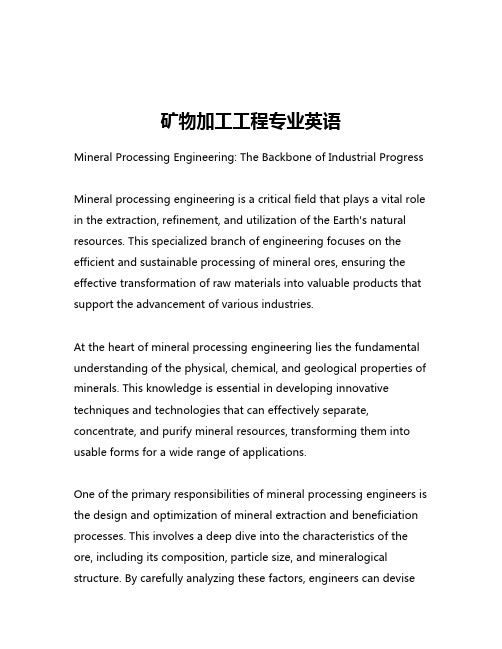
矿物加工工程专业英语Mineral Processing Engineering: The Backbone of Industrial ProgressMineral processing engineering is a critical field that plays a vital role in the extraction, refinement, and utilization of the Earth's natural resources. This specialized branch of engineering focuses on the efficient and sustainable processing of mineral ores, ensuring the effective transformation of raw materials into valuable products that support the advancement of various industries.At the heart of mineral processing engineering lies the fundamental understanding of the physical, chemical, and geological properties of minerals. This knowledge is essential in developing innovative techniques and technologies that can effectively separate, concentrate, and purify mineral resources, transforming them into usable forms for a wide range of applications.One of the primary responsibilities of mineral processing engineers is the design and optimization of mineral extraction and beneficiation processes. This involves a deep dive into the characteristics of the ore, including its composition, particle size, and mineralogical structure. By carefully analyzing these factors, engineers can devisetailored processing methods that maximize the recovery of the desired mineral components while minimizing waste and environmental impact.The processing of mineral ores typically begins with the crushing and grinding of the raw material, reducing it to smaller, more manageable sizes. This crucial step, known as comminution, prepares the ore for the subsequent separation and concentration stages. Mineral processing engineers employ a variety of techniques, such as gravity separation, flotation, and magnetic separation, to selectively isolate the valuable mineral components from the surrounding gangue (non-economic) materials.Gravity separation, for instance, utilizes the differences in the densities of minerals to facilitate their separation. Heavy minerals, such as gold or iron ore, can be effectively concentrated by exploiting their higher densities compared to the lighter gangue materials. Similarly, flotation processes leverage the surface properties of minerals, using specialized reagents to selectively facilitate the attachment of target minerals to air bubbles, allowing for their efficient separation.Furthermore, mineral processing engineers are responsible for the development and optimization of hydrometallurgical and pyrometallurgical processes, which involve the use of chemical andthermal methods to extract and refine metals from their ores. These advanced techniques play a crucial role in the production of a wide range of metals, from precious gold and silver to base metals like copper, zinc, and aluminum.Beyond the technical aspects of mineral processing, these engineers also play a vital role in ensuring the environmental sustainability of mining and mineral extraction operations. They work closely with environmental scientists and regulatory bodies to develop and implement strategies that minimize the ecological impact of these activities, including the treatment and disposal of waste materials, the mitigation of water and air pollution, and the restoration of mined land.The importance of mineral processing engineering cannot be overstated. As the global population continues to grow and the demand for natural resources escalates, the need for efficient and responsible mineral processing becomes increasingly crucial. Mineral processing engineers are at the forefront of this challenge, driving the development of innovative technologies and practices that enable the sustainable extraction and utilization of the Earth's mineral wealth.Their expertise is essential in maintaining the delicate balance between industrial progress and environmental stewardship,ensuring that the extraction and processing of minerals are carried out in a manner that maximizes economic benefits while minimizing the impact on the natural world.In conclusion, mineral processing engineering is a multifaceted discipline that is fundamental to the advancement of modern society. Through their technical expertise, problem-solving skills, and environmental awareness, mineral processing engineers play a pivotal role in shaping the future of resource utilization and industrial development. As the world continues to evolve, the importance of this field will only grow, solidifying its position as a cornerstone of industrial progress.。
矿物加工专业英语
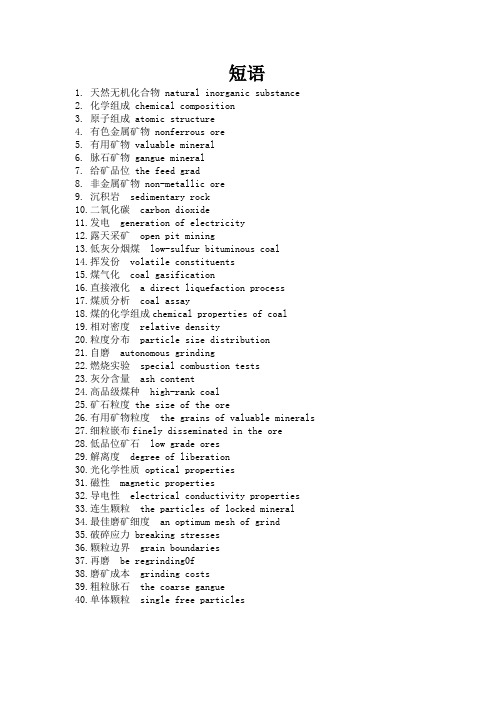
短语1.天然无机化合物 natural inorganic substance2.化学组成 chemical composition3.原子组成 atomic structure4.有色金属矿物 nonferrous ore5.有用矿物 valuable mineral6.脉石矿物 gangue mineral7.给矿品位 the feed grad8.非金属矿物 non-metallic ore9.沉积岩 sedimentary rock10.二氧化碳 carbon dioxide11.发电 generation of electricity12.露天采矿 open pit mining13.低灰分烟煤 low-sulfur bituminous coal14.挥发份 volatile constituents15.煤气化 coal gasification16.直接液化 a direct liquefaction process17.煤质分析 coal assay18.煤的化学组成chemical properties of coal19.相对密度 relative density20.粒度分布 particle size distribution21.自磨 autonomous grinding22.燃烧实验 special combustion tests23.灰分含量 ash content24.高品级煤种 high-rank coal25.矿石粒度 the size of the ore26.有用矿物粒度 the grains of valuable minerals27.细粒嵌布finely disseminated in the ore28.低品位矿石 low grade ores29.解离度 degree of liberation30.光化学性质 optical properties31.磁性 magnetic properties32.导电性 electrical conductivity properties33.连生颗粒 the particles of locked mineral34.最佳磨矿细度 an optimum mesh of grind35.破碎应力 breaking stresses36.颗粒边界 grain boundaries37.再磨 be regrinding0f38.磨矿成本 grinding costs39.粗粒脉石 the coarse gangue40.单体颗粒 single free particles选择1.gold and piatinum (native or metallic form)2.most of minerale (their composition)3.tow minerals that(quite different physical properties)4.granite is composed(different)汉译英1.矿石中有有用矿物与脉石矿物紧密共生 The useful minerals in the ore are intimately associated with the gangue minerals2.破碎一般为干式作业,采用分段方法完成 Crushing is usually a dry proless and is performed in seuerd stages3.在矿物晶体的晶格内,原子间键只在很短的距离内有效 In the crystalline latlice of minerals these inter-atomic bonds are effectine only over small distances4.新生成的表面通常具有更高的化学活性 Newly formed surfaces are often more chemically active5.在水存在的情况下,粉碎所需的能量减小The energy required for comminution is reduced in the presence of water6.粉碎学说研究输入能量与某一特定给料粒度下形成的产品粒度的关系Comminution theory is concerned with the relationship between energy input and the product particle size made from a given feed size7.在球磨机内,所输入的大部分能量用于产生热量 In a ball mill,the bulk of the energy being utilized in the production of heat8.物料的单位体积表面积与颗粒的直径成反比The surface area of unit volume of material is inversely proportional to the diameter9.也许测定矿石可磨度最广泛使用的参数是邦德功指数Probably the most widely used parameter to measure ore grindability is the Bond work index Wi10.批次实验取得的数据与标准可磨度实验数据具有很好的可比性,并且具有这样的优势,即测定功指数所需要的时间大大减少The batch-type tests compared very favourably with the standard grindability test date,the advantage being that less time is required to determine in the work index11.颚式破碎机是根据动鄂在枢轴上的悬挂方法分类的12.大块原矿截面可以大到1.5m13.由于给料不足和设备的机械问题,通常粗碎机设计的工作时间只有可利用时间的75%14.双肘板颚式破碎机的动鄂摆动运动受到连杆垂直运动的影响15.在破碎速度大于900t/h的矿山,总是选用旋回破碎机英译汉1.the abundance of metals in the ocean is related to some extent to thecrustal abundancies, 海洋中蕴含丰富的金属,在某种程度上与地壳的风度有关,因为这些金属来自于地壳的风化2.it is apparent that 显然,如果含有重要金属的矿物是均匀的分布于地球,那么他们将如此稀疏的分散开来,以至于经济的开采是不可能的3.a particular mineral may 一种特殊的矿物被发现主要与花岗岩共生在一起或者与岩浆岩或者沉积岩共生在一起,也就是,由于早期的岩石在水,冰与化学衰变的作用下产生力学和化学的风化作用而形成的矿床生成的矿物4.A direct liquefaction process 一种直接的碳的液化过程,即伯吉尤斯过程(通过氢化作用达到液化),也仅仅是在一战和二战期间在德国内使用5.Among commercially mature technologies 据威廉母斯和****在2003年报告在商业化成熟的技术中,间接的碳的液化过程由于直接的碳的液化过程6.All of these liquid fuel 在碳的转化过程中,所有液化燃料的产生方式中所释放的CO2远远大于从石油中提取和提炼液态燃料中所释放的CO2.7.Estimates are reported for sites in china 有报道估计在中国的某些地方碳的液化收支平衡的价格是每桶油卖到25到35美元bustion of coal 煤的燃烧像其他的任何化石燃料一样,产生CO2和氮氧化物,并伴随变化的SO2量,并且SO2的含量取决于煤的产地9.Sulfur dioxide reacts with oxygen SO2和O2反应生成SO3,SO3与水反应生成硫酸,硫酸又以酸雨的形式返回内地10.Jet is a geological material 煤精是一种地质材料,并不被认为是一种真正的矿物,但可以被认为是一种准矿物,在极端的压力作用下从腐朽的木材中得到,因此是一种有机的准矿物11.Ash fusion temperatures 熔融的煤灰温度是通过高温熔炉的观察窗观察煤灰的一个模制试样来测定的12.If the ore contains worthwhile 如果矿石中含有大量的多于**的矿物,那么通常情况下对矿物的分选是矿物加工的目的13.Similarly if undesirable minerals 类似情况下,如果矿石中有可能不需要的矿物存在,就是可能接下来干涉分选过程的存在,去除他们是必要的14.Apart from economics 除了从经济方面考虑以外,能量消耗也是极为重要的问题,因为世界上有丰富的矿物储备,能够满足本世纪接下来最普通的金属需要,但是没有足够的能量来生产这些金属15.However in the majority of cases 然而在大量的事例中,消耗在熔炼和低品味矿石中的能量是如此的大16.Mineral processing reduces the bulk17.One of the major objects of comminution 破碎的目标之一就是从共生的脉石矿物中在最初的可能粒度级解离或释放出有价值的矿物18.Up till recently it has been直到现在,对矿物学家而言,对这个问题给出定量答案也是不可能的一种特定的矿石被研磨到何等细的粒度生产出一种有价值矿物的解离度19.During the grinding of 在对低品位矿石的研磨过程中,脉石矿物的脉体通常在一种相对较粗的尺寸被解离出来20.It is often used on minerals这种方法被使用在容易从自由脉石中解离出来的矿物上,尽管矿物本身在某种程度上与脉石共生在一起、21.The grade(metal content)of ore 采出或加工的矿石的品味(金属含量)依靠多种因素,一般情况下低品位矿石比高品位矿石处理量要大22.The texture refers to结构指的是有用矿物在矿石中的聚合粒径和分布状态23.The nature of the minerals 矿物的性质很重要,因为有价值的矿物和脉石矿物之间在一些物理性质上的显著差异对于矿物加工是十分必要的24.Deep mining is expensive compared 深采与露天开采和冲击作业相比代价是昂贵的,仅对于高品位的矿石才是有利的25.The world is now becoming世界逐渐意识到资源的有限性与大矿新矿日益增加的开发成本***26.This is achieved by comminution在分选之前解离靠粉碎来完成,矿石颗粒粒度逐渐减小,直到矿物的颗粒用现有的方法能解离出来27.Crushing reduces the particle在破碎原矿石的颗粒减小到一定的水平,以至于研磨能够顺利的实施直到矿物和脉石作为独立的颗粒在大体上被分离出来28.Duo to this increase 由于表面能的增加,新形成的表面通常具有更高的化学活性更易于受化学药剂的作用等,同时更容易氧化29.When an irregular particle is当一个不规则的颗粒被挤压或者破碎断裂时,产品变成两个不同的粒度范围——粗颗粒由拉力导致断裂,细颗粒来自载粒附近压力导致的断裂或者在突起不分的剪切力导致的断裂30.Values of operating work 设备从特定的单元获得的功指数的值能够用来评估操作变量的效果,如磨机的速度,研磨媒介的尺寸以及衬里的类型。
矿物加工专业英语课后题短语、单词

PAERT1 短语Unit1 lesson 1天然无机化合物natural inorganic substances 化学组成chemical compositions原子结构atomic structure有色金属矿石nonferrous ores有用矿物valuable minerals脉石矿物gangue minerals给矿品位feed grades非金属矿石non-metallic oresLeson2沉积岩sedimentary rocks 二氧化碳carbon dioxide发电power generation露天采矿open pit mining低灰分烟煤low-ash bituminous coal挥发分volatile constituents煤气化coal gasification直接液化direct liquefactionLesson3煤质分析coal assay煤的化学性质chemical properties of coal相对密度relative density 粒度分布particle size distribution自磨autonomous grinding燃烧试验combustion test灰分含量ash content of coal高品级煤high-rank coalLesson4矿石粒度the size of ores有用矿物颗粒the grains of valuable minerals低品位矿石low-grade ores解离度degree of liberation光学性质optical properties 磁性magnetic property导电性electrical conductivity propertiesLesson5连生颗粒locked particles最佳磨矿细度optimum mesh of grind破碎应力the breaking stresses颗粒边界mineral grain boundaries再磨regrind磨矿成本grinding costs粗粒脉石the coarse gangue单体颗粒single particlesUNIT3 Lesson1颗粒层厚度the thickness of the layer筛分效率the efficiency of screening难筛颗粒near mesh particlesUNIT4Lesson1 p78低品位复杂矿石low-grade complex ores预选pre-concentrate脱水dewatering矿物比重specific gravity of the mineral理想给料浓度an optimum feed pulp-densityLesson2 P84补偿水流supplied water干涉沉降hindered settling起始加速度the initial acceleration简谐运动harmonic motionLesson3 p88颗粒的横向运动 a lateral displacement of the material流膜分选flowing-film separation给矿槽the feed box冲刷水wash water径向振动vibrate longitudinally垂直分层vertical stratification耐磨材料hard wearing material矿砂摇床sand tablesPART 2句子UNIT TWO comminution (粉碎)L1 principles of comminution(粉碎原理)1、minerals are intimately associated with the gangue.矿石中有用矿物与脉石紧密共生。
矿物加工工程专业英语
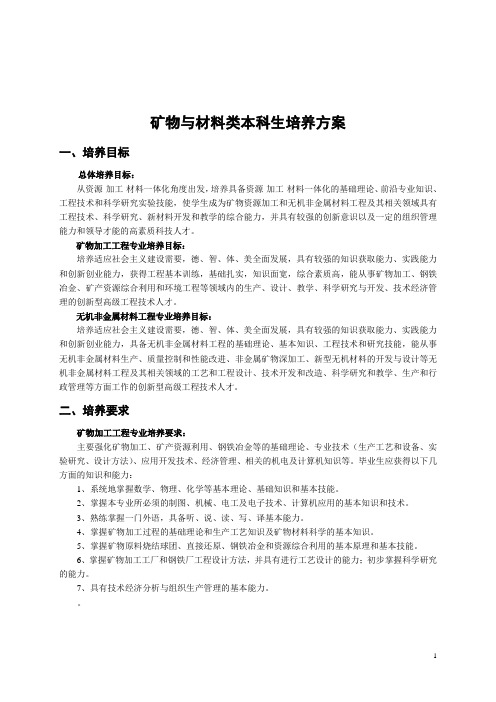
矿物与材料类本科生培养方案一、培养目标总体培养目标:从资源-加工-材料一体化角度出发,培养具备资源-加工-材料一体化的基础理论、前沿专业知识、工程技术和科学研究实验技能,使学生成为矿物资源加工和无机非金属材料工程及其相关领域具有工程技术、科学研究、新材料开发和教学的综合能力,并具有较强的创新意识以及一定的组织管理能力和领导才能的高素质科技人才。
矿物加工工程专业培养目标:培养适应社会主义建设需要,德、智、体、美全面发展,具有较强的知识获取能力、实践能力和创新创业能力,获得工程基本训练,基础扎实,知识面宽,综合素质高,能从事矿物加工、钢铁冶金、矿产资源综合利用和环境工程等领域内的生产、设计、教学、科学研究与开发、技术经济管理的创新型高级工程技术人才。
无机非金属材料工程专业培养目标:培养适应社会主义建设需要,德、智、体、美全面发展,具有较强的知识获取能力、实践能力和创新创业能力,具备无机非金属材料工程的基础理论、基本知识、工程技术和研究技能,能从事无机非金属材料生产、质量控制和性能改进、非金属矿物深加工、新型无机材料的开发与设计等无机非金属材料工程及其相关领域的工艺和工程设计、技术开发和改造、科学研究和教学、生产和行政管理等方面工作的创新型高级工程技术人才。
二、培养要求矿物加工工程专业培养要求:主要强化矿物加工、矿产资源利用、钢铁冶金等的基础理论、专业技术(生产工艺和设备、实验研究、设计方法)、应用开发技术、经济管理、相关的机电及计算机知识等。
毕业生应获得以下几方面的知识和能力:1、系统地掌握数学、物理、化学等基本理论、基础知识和基本技能。
2、掌握本专业所必须的制图、机械、电工及电子技术、计算机应用的基本知识和技术。
3、熟练掌握一门外语,具备听、说、读、写、译基本能力。
4、掌握矿物加工过程的基础理论和生产工艺知识及矿物材料科学的基本知识。
5、掌握矿物原料烧结球团、直接还原、钢铁冶金和资源综合利用的基本原理和基本技能。
矿物加工专业英语
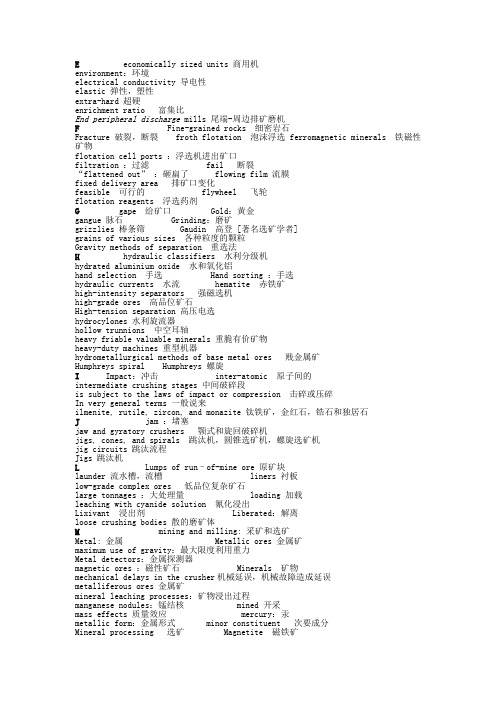
E economically sized units 商用机environment:环境electrical conductivity 导电性elastic 弹性,塑性extra-hard 超硬enrichment ratio 富集比End peripheral discharge mills 尾端-周边排矿磨机F Fine-grained rocks 细密岩石Fracture 破裂,断裂 froth flotation 泡沫浮选ferromagnetic minerals 铁磁性矿物flotation cell ports :浮选机进出矿口filtration :过滤 fail 断裂“flattened out”:砸扁了 flowing film 流膜fixed delivery area 排矿口变化feasible 可行的 flywheel 飞轮flotation reagents 浮选药剂G gape 给矿口 Gold:黄金gangue 脉石 Grinding:磨矿grizzlies 棒条筛 Gaudin 高登 [著名选矿学者]grains of various sizes 各种粒度的颗粒Gravity methods of separation 重选法H hydraulic classifiers 水利分级机hydrated aluminium oxide 水和氧化铝hand selection 手选 Hand sorting :手选hydraulic currents 水流 hematite 赤铁矿high-intensity separators 强磁选机high-grade ores 高品位矿石High-tension separation 高压电选hydrocylones 水利旋流器hollow trunnions 中空耳轴heavy friable valuable minerals 重脆有价矿物heavy-duty machines 重型机器hydrometallurgical methods of base metal ores 贱金属矿Humphreys spiral Humphreys 螺旋I Impact:冲击 inter-atomic 原子间的intermediate crushing stages 中间破碎段is subject to the laws of impact or compression 击碎或压碎In very general terms 一般说来ilmenite, rutile, zircon, and monazite 钛铁矿,金红石,锆石和独居石J jam :堵塞jaw and gyratory crushers 颚式和旋回破碎机jigs, cones, and spirals 跳汰机,圆锥选矿机,螺旋选矿机jig circuits 跳汰流程Jigs 跳汰机L Lumps of run–of-mine ore 原矿块launder 流水槽,流槽 liners 衬板low-grade complex ores 低品位复杂矿石large tonnages :大处理量 loading 加载leaching with cyanide solution 氰化浸出Lixivant 浸出剂 Liberated:解离loose crushing bodies 散的磨矿体M mining and milling: 采矿和选矿Metal: 金属 Metallic ores 金属矿maximum use of gravity:最大限度利用重力Metal detectors:金属探测器magnetic ores :磁性矿石 Minerals 矿物mechanical delays in the crusher机械延误,机械故障造成延误metalliferous ores 金属矿mineral leaching processes:矿物浸出过程manganese nodules:锰结核 mined 开采mass effects 质量效应 mercury:汞metallic form:金属形式 minor constituent 次要成分Mineral processing 选矿 Magnetite 磁铁矿mine machinery :采矿机械more chemically active 更具有化学活性more amenable to the action of flotation reagents 更容易与浮选药剂发生作用N non-ferrous minerals 有色金属矿物native:自然的 Non-metallic Ores 非金属矿non-conducting minerals 非导体矿物natural beds:矿床 nip 捏, 夹。
专业英语1

abundance of metals: 金属含量 to some extent:在一定程度上 weathering of the crustal rocks:地壳岩石的风化 acid rain-waters:酸雨 mineral leaching processes:矿物浸出过程 the crustal abundance:地壳含量 manganese nodules:锰结核 oxygen-rich waters:富氧水 the Pacific Ocean:太平洋
矿物加工专业英语[1]
1.1 Mineral and Ores 矿物与矿石 1.1.1 Minerals 矿物 The forms in which metals are found in the crust of the earth and as seabed deposits depend on their reactivity with their environment, particularly with oxygen, sulphur, and carbon dioxide. Gold and the platinum metals are found principally in the native or metallic form. Silver, copper, and mercury are found native, as well as in the form of sulphides, carbonates, and chlorides. The more reactive metals are always in compound form, such as the oxides and suphides of iron and the oxides and silicates of aluminium and beryllium. The naturally occurring compounds are known as minerals, most of which have been given names according to their composition [e.g. galena---lead sulphide, PbS; sphalerite---zinc sulphide, ZnS; cassiterite---tin oxide, SnO2].
矿物加工专业英语——分级

4.5.10
格筛
grizzly
用来对较大粒度(例如:150 mm)进行粗略分级的筛分机。
注:格筛可由固定的或运动的棒条、圆盘或成型的滚轴组成。
4.5.11
弧形筛
Sieve bend
筛面沿纵向呈固定弧形,筛条与入料运动方向垂直排列的一种条缝筛。
编号
术语名称
英文名称
定义或说明
代号
允许使用的同义词
禁止使用的同义词
筛分试验
Size analysis
为了解煤的粒度组成和各粒级产物的特性而进行的筛分和测定。各粒级的数质量均用占全样的百分数来表示。
4.1.04
小筛分
Sieve analysis
对粒度小于0.5mm的物料进行的筛分试验。
4.1.05
平均粒度
Mean size
任一试样,或一批特定的颗粒物料其粒度大小的加权平均值。
4.6
在气流或水流中分级
Sizing in a current of air or water
4.6.01
风力分级
Air classification
在空气流中进行的分级工艺。
4.6.02
分级机
classifier
一种按照粒度,形状或密度的差异,用与筛分方法以外的其它物理方法使颗粒进行分级的设备。
4.6.03
4.1.08
筛下粒
undersize
产物中小于额定粒度上限的颗粒,可用占产物的百分数表示。
4.1.09
粉尘
dust
粒度细到足以在空气中悬浮的固体物料颗粒。
4.1.10
粉煤
fines
通常指粒度为0~6mm的煤。
注:国际标准通常指0~4mm的煤。
- 1、下载文档前请自行甄别文档内容的完整性,平台不提供额外的编辑、内容补充、找答案等附加服务。
- 2、"仅部分预览"的文档,不可在线预览部分如存在完整性等问题,可反馈申请退款(可完整预览的文档不适用该条件!)。
- 3、如文档侵犯您的权益,请联系客服反馈,我们会尽快为您处理(人工客服工作时间:9:00-18:30)。
Unit1 Lesson11 矿物(minerals)Minerals definition: Minerals by definition are natural inorganic substances possessing definite chemical compositions and atomic structures.矿物的定义:具有稳定的化学成分、晶体结构的天然无机化合物。
Mineral types: native and metallic form, oxides, sulphides, carbonates, silicates and chlorides.矿物的种类:主要按化学成分划分:单质矿物、氧化物、硫化物、碳酸盐、硅酸盐、卤化物等。
Isomorphism: substitution of atoms within the crystal structure by similar atoms takes place without affecting the atomic structure.类质同象:矿物晶体中的原子被类似原子取代而不改变矿物晶体结构的现象。
例如:铁橄榄石—镁橄榄石。
Polymorphism: different minerals have the same chemical composition, but markedly different physical properties due to a difference in atomic structure.同质多象:矿物的化学成分相同,但晶体结构和物理化学性质不同的现象。
例如:金刚石、石墨。
Rocks: Rocks consist of a variety of minerals and form large parts of the earth’s crust. Granite, for instance, which is the most abundant igneous rock, is composed of three main mineral constituents, feldspar, quartz, and mica.岩石:由一种或多种矿物组成的天然集合体,例如:花岗岩主要由石英、长石、云母以不同比例组成。
2 矿石oresOre: An ore can be described briefly as an accumulation of mineral in sufficient quantity as to be capable of economic extraction.矿石:具有经济利用价值的矿物集合体.Classification: (1)Ores are frequently classed according to the nature of the valuable mineral, such as native ores, sulphide ores and oxidised ores. (2)Ores are also classified by the nature of their gangues, such as calcareous or basic (lime rich), or siliceous, or acidic (silica rich)矿石的分类:(1)根据有用矿物的性质分为:自然元素矿石(单质矿石)、硫化矿和氧化矿等。
(2)根据脉石矿物的性质分为:钙质矿石、硅质矿石、酸性矿石等。
3 金属矿石与非金属矿石metallic ores and non-metallic oresOres of economic value can be classed as metallic (when it is used to prepare the metal) or non-metallic (when it is used to make material), according to the use of the mineral.根据矿物的用途划分:如果以提取矿物中的金属为目的,则成为金属矿石;如果矿物直接利用,则称之为非金属矿石。
Review of the last lesson1 矿物(minerals)Minerals by definition are natural inorganic substances possessing definite chemical compositions and atomic structures.Isomorphism: Many minerals exhibit isomorphism, where substitution of atomswithin the crystal structure by similar atoms takes place without affecting the atomic structure.Polymorphism: Minerals can also exhibit polymorphism, different minerals having the same chemical composition, but markedly different physical properties due to a difference in atomic structure.2 矿石oresOre: An ore can be described briefly as an accumulation of mineral in sufficient quantity as to be capable of economic extraction.3 金属矿石与非金属矿石metallic ores and non-metallic oresOres of economic value can be classed as metallic (when it is used to prepare the metal) or non-metallic (when it is used to make material), according to the use of the mineral.Lesson2Types of coal煤的种类Lignite, Sub-bituminous coal, Bituminous coal and Anthracite.主要包括:褐煤、亚烟煤、烟煤、无烟煤Coking and use of coke炼焦及焦炭的应用Coke is a solid carbonaceous residue derived from low-ash, low-sulfur bituminous coal from which the volatile constituents are driven off by baking in an oven without oxygen at temperatures as high as 1,000 °C (1,832 °F) so that the fixed carbon and residual ash are fused together.焦炭是一种从低灰、低硫的烟煤中获得的固态碳质残余物,烟煤在隔绝氧气的条件下和1000度的高温下焙烧,驱除其中的挥发份,使固定碳和残留灰分熔融在一起。
GasificationCoal gasification breaks down the coal into its components, usually by subjecting it to high temperature and pressure, using steam and measured amounts of oxygen.煤气化是将煤分解为不同的组分,通常是使用蒸汽和一定量的氧气气氛,在高温、高压条件下进行。
Liquefaction液化包括间接液化和直接液化两种方法Indirect synthesis: Coal would be gasified to make syngas and the syngas can be condensed using Fischer-Tropsch catalysts(催化剂) to make light hydrocarbons which are further processed into gasoline and diesel.间接液化:首先将煤气化为合成气,然后在催化剂作用下将合成气浓缩制备轻质烃油,轻质烃油在进一步转化为汽油和柴油。
Direct liquefaction processes: liquefaction by hydrogenation, Solvent Refined Coal, Karrick process直接液化:包括加氢液化、溶剂精炼、Karrick法等。
The Fischer-Tropsch process (or Fischer-Tropsch Synthesis) is a catalyzed chemical reaction in which synthesis gas (syngas), a mixture of carbon monoxide and hydrogen, is converted into liquid hydrocarbons of various forms.The most common catalysts are based on iron and cobalt, although nickel andruthenium have also been used. The principal purpose of this process is to produce a synthetic petroleum substitute, typically from coal, natural gas or biomass, for use as synthetic lubrication oil or as synthetic fuel.Sasol (South African Coal and Oil) is a South African company involved in mining, energy, chemicals and synfuels. In particular, they produce petrol and diesel profitably from coal and natural gas using Fischer-Tropsch synthesis.The Bergius Process is a method of production of liquid hydrocarbons for use as synthetic fuel by hydrogenation of lignite (brown coal) at high temperature and pressure. It was first developed by Friedrich Bergius in 1913. Lignite or sub-bituminous coal is finely ground and mixed with heavy oil recycled from the process. Catalyst is typically added to the mixture. A number of catalysts have been developed over the years, including tungsten or molybdenum sulfides, tin or nickel oleate, and others.Naphtha normally refers to a number of different flammable liquid mixtures of hydrocarbons, i.e. a distillation product from petroleum or coal tar boiling in a certain range and containing certain hydrocarbons, a broad term encompassing any volatile, flammable liquid hydrocarbon mixture.The Karrick process is a low-temperature carbonization (LTC) of coal, shale, lignite or any carbonaceous materials. These are heated at 680°F (360°C) to 1380 °F (360 °C to 749 °C) in the absence of air to distill out oil and gas. The process was the work of oil shale technologist at the U.S. Bureau of Mines in the 1920s.China has announced high volume commercial coal liquefaction production in late 2007[1], after a successful trial, starting a process that could rapidly free China from dependency upon external OPEC oil imports. The process is reported to have '60-meter-high cylindrical structures' and to be a direct coal liquefaction process. While lacking formal confirmation, the process described seems identical to the Karrick process.Review of the last lessonTypes of coal煤的种类Lignite, Sub-bituminous coal, Bituminous coal and Anthracite.Coking and use of coke炼焦及焦炭的应用Coke is a solid carbonaceous residue derived from low-ash, low-sulfur bituminous coal from which the volatile constituents are driven off by baking in an oven without oxygen at temperatures as high as 1,000 °C so that the fixed carbon and residual ash are fused together.Gasification 汽化Coal gasification breaks down the coal into its components, usually by subjecting it to high temperature and pressure, using steam and measured amounts of oxygen.Liquefaction液化Indirect synthesis: Coal would be gasified to make syngas and the syngas can be condensed using Fischer-Tropsch catalysts to make light hydrocarbonswhich are further processed into gasoline and diesel.Direct liquefaction processes: liquefaction by hydrogenation, Solvent Refined Coal, Karrick processThe Fischer-Tropsch process is a catalyzed chemical reaction in which synthesis gas, is converted into liquid hydrocarbons of various forms.The Karrick process is a low-temperature carbonization (LTC) of coal, shale, lignite or any carbonaceous materials. These are heated at 360 °C to 749 °C in the absence of air to distill out oil and gas.Lesson3IntroductionCoal assay techniques are specific analytical methods designed to measure the particular physical and chemical properties of coals煤质分析技术是指用于分析煤的物理和化学性质的特定分析方法。
